Beach combing- Art at the beach- Sports on the sand & in water
pLAYING wITH nATURE
This page is all about how to look like an expert outside
Sometimes it just takes a little bit of reading…
Start Small. Never Stop.
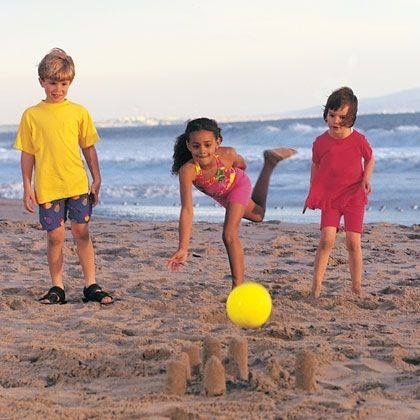
Beach Combing
I have spent my entire life trying to get rid of the universal notion that any type of family walks and hikes are all about getting to a certain destination. When in reality walks, like beach combing, are really all about the adventure and the the things that fascinate us along the way. Just ask any of your children and you can count on them to find the fun stuff along the way. They are outside to discover and find joy in the process of exploring the plants and animals that are right in front of them. So add in some spontaneous "Natural STEAM" activities and enrichment that are featured below.
By letting your child's interest levels set the pace for walking the shoreline, while we are being open to their natural curiosity, we can definitely help any child to develop a healthy love of not just the beach but of the entire great outdoors.
Building & Displaying A Nature Collection
Discovering Forest Collectables
Incredibly Easy Nature Program
Ocean Safety 101: How to Stay Safe in The Water
I realized after taking my 20-something-year-old friend to swim in the ocean for the first time — and she screamed, jumped and came running at me the moment she saw a miniature crab — that not everyone understands that the ocean is more than just a really big pool.
Not only is it full of living creatures, but the water itself is mysterious, unpredictable and can be really dangerous if you aren't smart when you are out in it.

Here are a few ocean safety tips to keep you safe when hitting the beach (other then the obvious like wearing sunscreen and staying hydrated, of course).
Watch out for sleeper waves
These waves are the ones that crash further up on the beach than normal and can knock over small children, or people who don't have steady footing, and pull you out to sea. Be careful when walking near the water line along the beach.
When swimming be careful of rip currents
Rip currents are swift rivers of backwash that surge through the surf (the choppy, foamy or discoloured water near the shore). If you are caught in one, DO NOT swim against it. Swim parallel to the beach until you are free of the current, and then head for shore.
Stay away from rocks, driftwood and piers
Like icebergs, it is hard to tell how big the rock is underneath the water until you have scraped your hands and knees on it. Unexpected currents and large waves can push you into these obstacles as well, causing a lot of damage.
Watch out for reefs
Reefs are pretty easy to spot, they are usually a dark shadow in otherwise clear or blue water. You can also spot them by the waves that usually break over them. Not only can you risk damaging the fragile ecosystem if you step, kick, or otherwise knock into a reef, but a scrape can cause a nasty infection.
Stay alert for fish and other critters
Jellyfish are usually easy to spot, as are small crabs that are more afraid of you then you are of them. Shuffle your feet when entering the water if you are somewhere that has stingrays present, and never go in the water with open wounds — no need to tempt the sharks!
When in doubt, ask a lifeguard
The lifeguards are aware of currents, tides, and any type of critters that might be present on the beach. If there are not lifeguards on the beach that you are headed to, do a bit of research ahead of time or, if nothing else, make a conscious decision to be alert and aware of your surroundings.
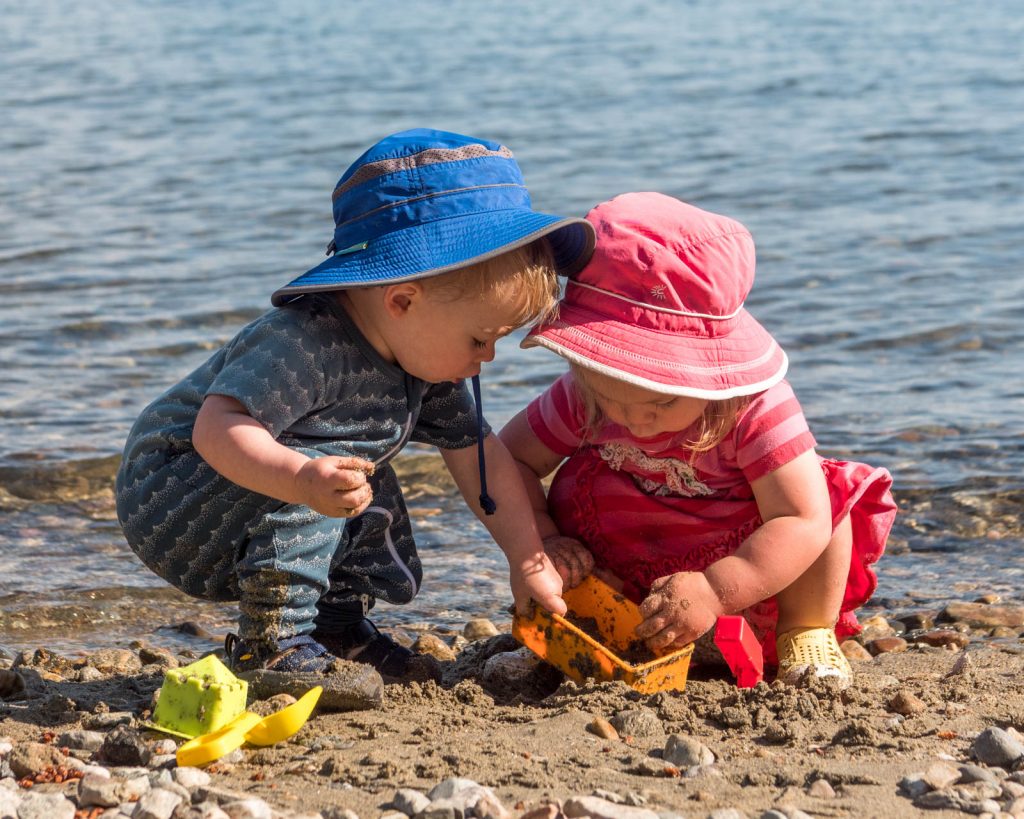
THINGS TO KNOW
Did you know there are over 11,000 species of seaweed in the world, 600 of which can be found in the UK. Seaweed provides food and shelter to a variety of marine creatures as well as producing oxygen, capturing carbon, absorbing toxins and in some cases even reducing the acidity of sea water.

You might be surprised to find that seaweed isn’t a plant, it is actually a type of algae. Seaweed doesn’t use or have stems or roots to transport nutrients or water from the ground to its system. Instead it uses its cells to absorb or develop what it needs from the water as well as absorbing energy from the sun and convert it into food using a process called photosynthesis. A by product of photosynthesis is oxygen which gets re-released back into the atmosphere an amazing 40-50% of the oxygen in our atmosphere is believed to be produced by seaweed.
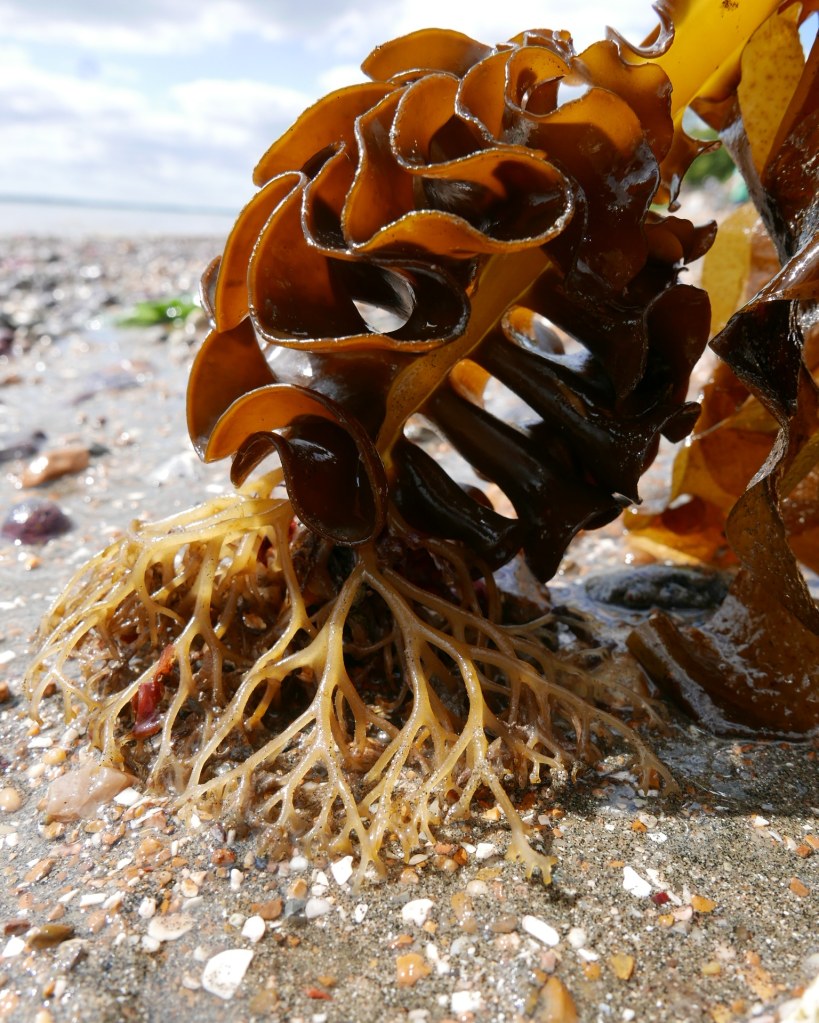
As seaweed doesn’t have roots it anchors itself to surfaces using a structure called a holdfast instead. Seaweed can come in a variety of shapes, sizes and colours. However they can generally be grouped into three main categories of red, green and brown. They can survive in a variety of marine habitats from rock pools and shore lines, on rock beds along coastal line and even sometimes free floating in the ocean.
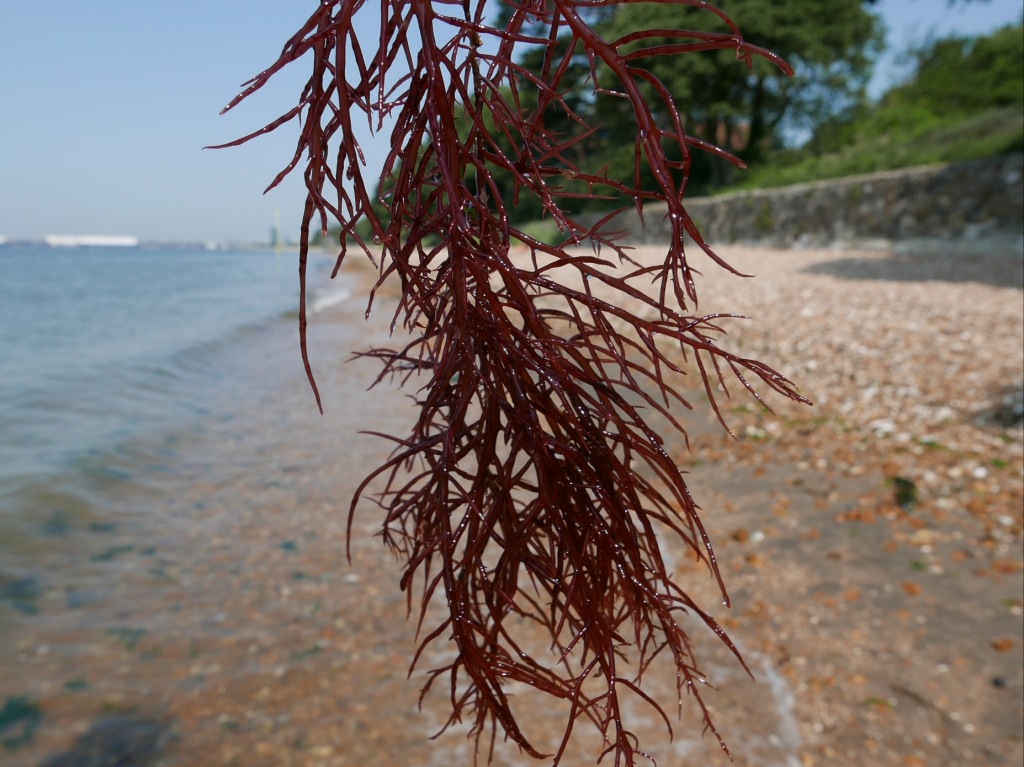
Some varieties of seaweed are edible and are considered good sources of nutrients like fibre, protein, vitamins and minerals. Seaweed has been used throughout human history as a source of food and medicine as well as being utilised for industrial purposes. From paper coatings, adhesives and dental moulds to food additives, fertilizer and edible packaging.
Children can use the books below or the internet as a reference for reading about how sand is made, the benefits of eating seaweed, or any other questions they have about the beach or the ocean. Here are some books that would fit well:
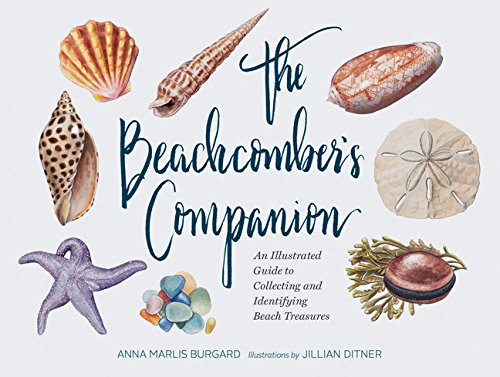
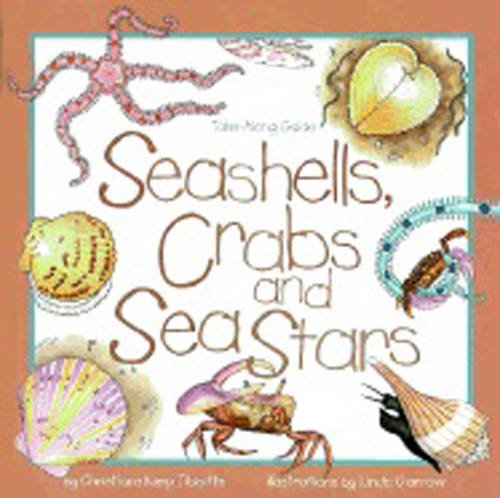
Seashells, Crabs and Sea Stars
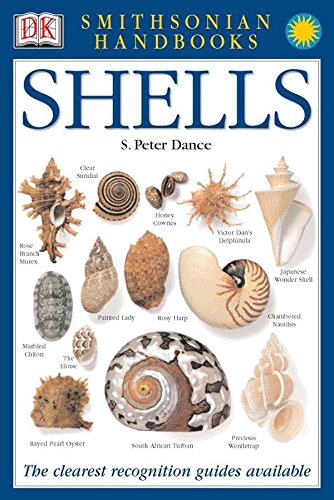
Communication: Kids can expand their vocabulary as they learn about the ocean, sea life, and the beach on their walk. They can further that discussion when filling the bottle and exploring it afterwards. This gives them the opportunity to ask questions and to talk about their discoveries.
Beach Combing Activities
Hope was four when we moved to Florida and it offered so many new and exciting ways to explore nature. We celebrated having new habitat to explore and have fun in. New animals to learn about and new flowers and vegetation to discover.
By letting your child's interest set the pace for walking the shoreline, and by us being open to their natural curiosity, we can definitely help any child to develop a healthy love of not just the beach but of the great outdoors.
The Basics of Beachcombing
Beachcombing involves walking along the seashore to find items washed ashore by the ocean.
Common finds include seashells, sea glass, driftwood, and occasionally, more exotic treasures like lost jewelry or ancient artifacts.
Preparation is key:
Wear comfortable footwear suitable for walking on sand.
Bring a bag or bucket for your finds.
Check the tide schedules, as items are more likely to appear around low tide.
Beachcombing involves walking along the seashore to find items washed ashore by the ocean.
Common finds include seashells, sea glass, driftwood, and occasionally, more exotic treasures like lost jewelry or ancient artifacts.
Locations matter: Some beaches are more fruitful than others.
Choose less crowded spots for better chances of finding unique items. Beaches with strong currents or located near old ports can offer more interesting finds.
Engaging in beachcombing not only provides a sense of adventure but also fosters a deep appreciation for the ocean and its ecosystems.
It encourages you to spend time outdoors and observe the subtle changes in the coastline.
For more on beachcombing and collecting on the beach CLICK HERE
How to Find Sea Creatures
at the Beach
at the Beach
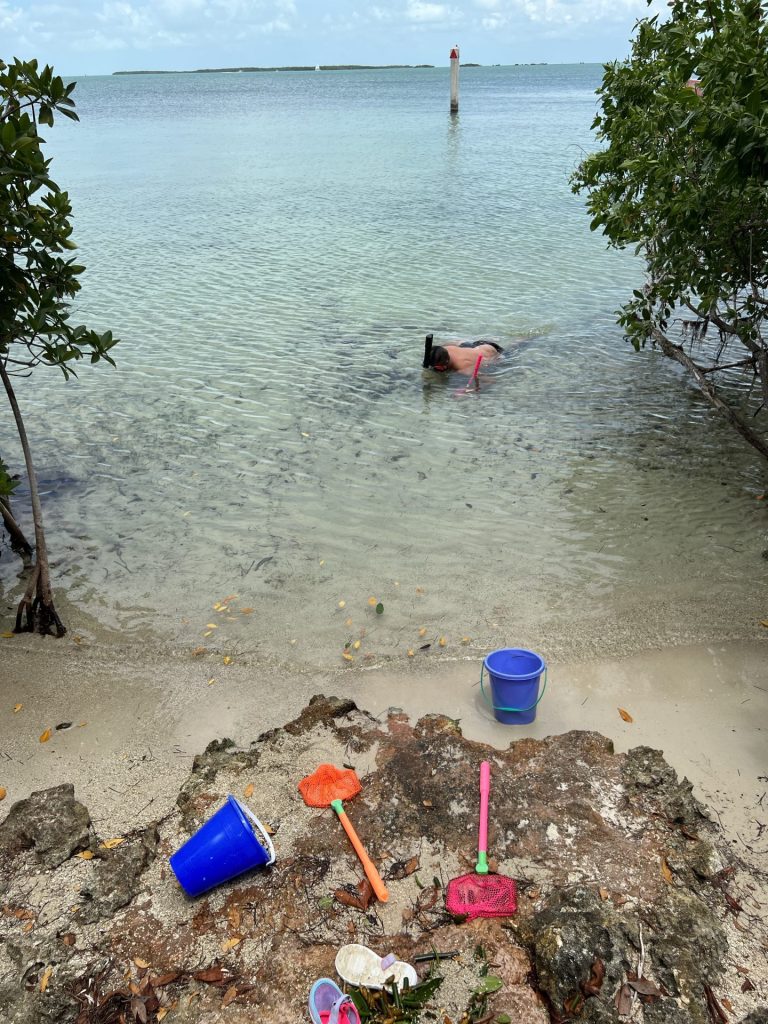
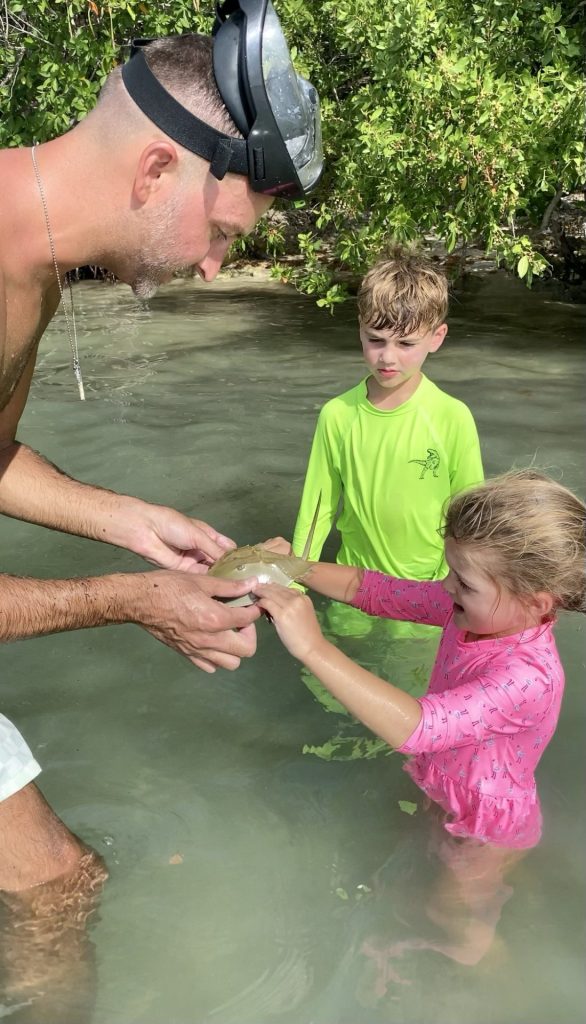
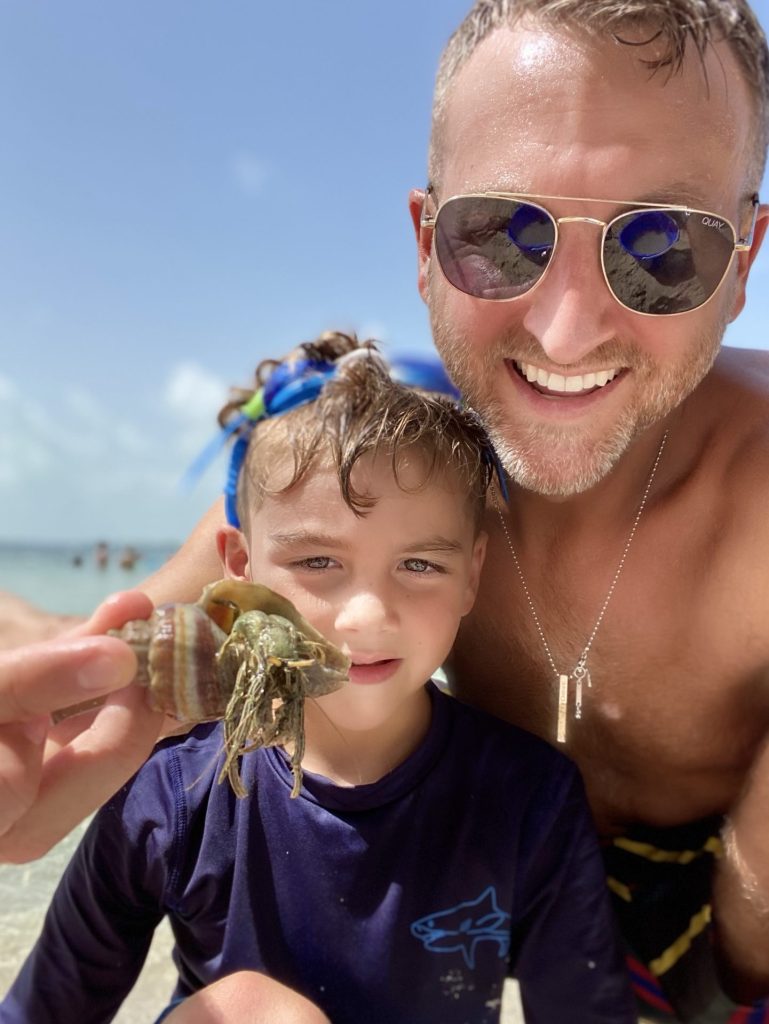
Want to know how to find cute sea creatures at the beach? It’s actually quite easy to find crabs, baby shrimp, fish, starfish, and seahorses! You just need to know where to look and the tools needed! Curiosity about the world starts with our littlest guys when they are still teeny, and we, as parents and teachers, must continue it with modeling and supported explorations like this. Happy beach time!
Look in the seaweed
Florida beaches have been littered with large brown sargassum seaweed lately. Sargassum is a type of algae that floats in large groups and never attaches to the seafloor. Animals like to live and camouflage in the floating seaweed islands.
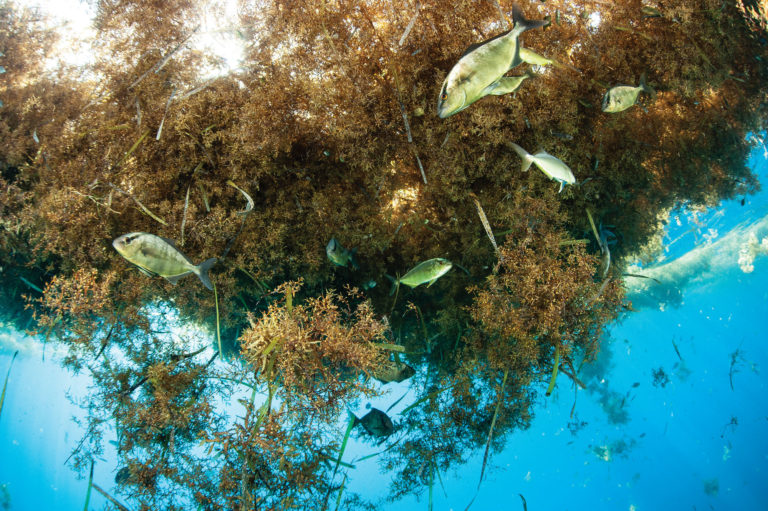
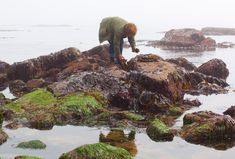
Baby fish hiding in the sargassum seaweed. | Credit: sportfishingmag.com
Finding sea life at the beach is one our kids favorite things to do. This activity can keep them busy for hours. We love to learn about them and see what new sea critters we can discover. It’s important to always catch and release the sea animals back into the ocean.
What you need to find cute sea creatures?
A net – these are our favorite
A bucket with sea water. (Tip: the lighter the bucket the better you’ll be able to see the sea life)
What we find in the seaweed:
Ghost shrimp
Crabs
Baby fish
Seahorse
How to find sea creature in seaweed
Fill your bucket with sea water.
Net the floating seaweed and put it in your bucket and gently swirl around.
Say hello to your new sea friends!
The crabs you find will actually change colors. The start out as grayish color and as they live on the sargassum they will start to turn a yellow brown to match the surroundings.
More ways to find sea life
at the beach
Under the sand you can find Atlantic mole crabs, locals call them sand crabs. We first discovered these during a trip to Siesta Key, Fl.
Tidal pools and during low tide is when you can find starfish, mussels and sea snails the best. Always look near the rocks.
In the seagrass is where seahorses like to hang out. Be very careful when looking here as they’re very fragile. These are our favorite snorkels to find them.
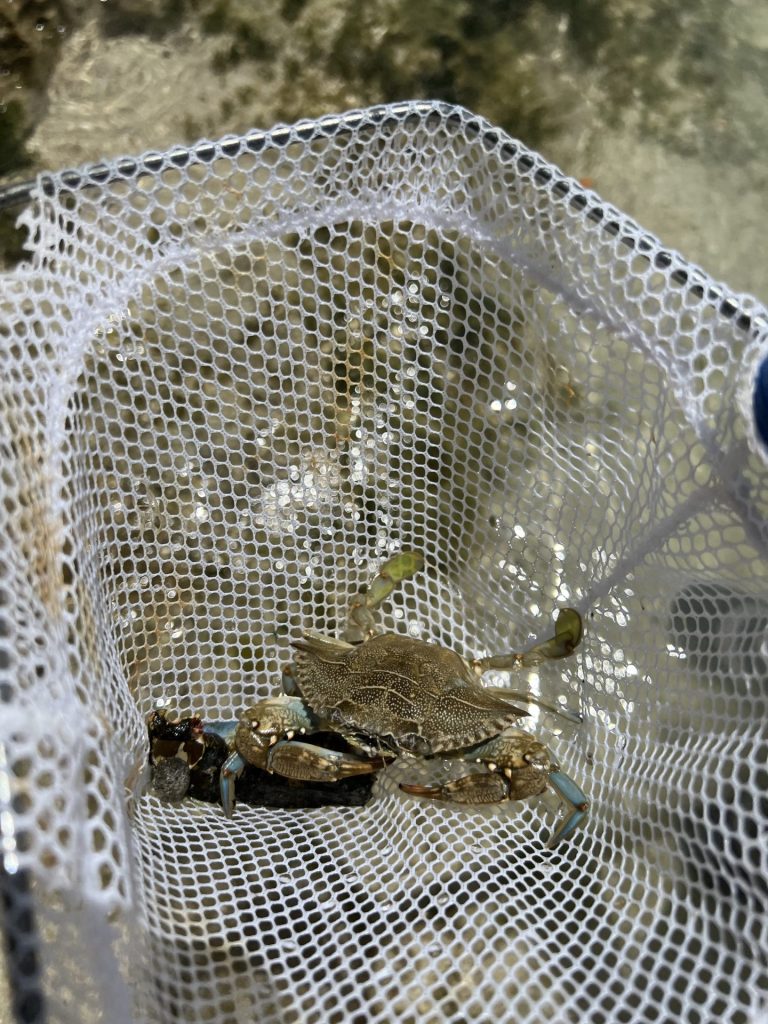
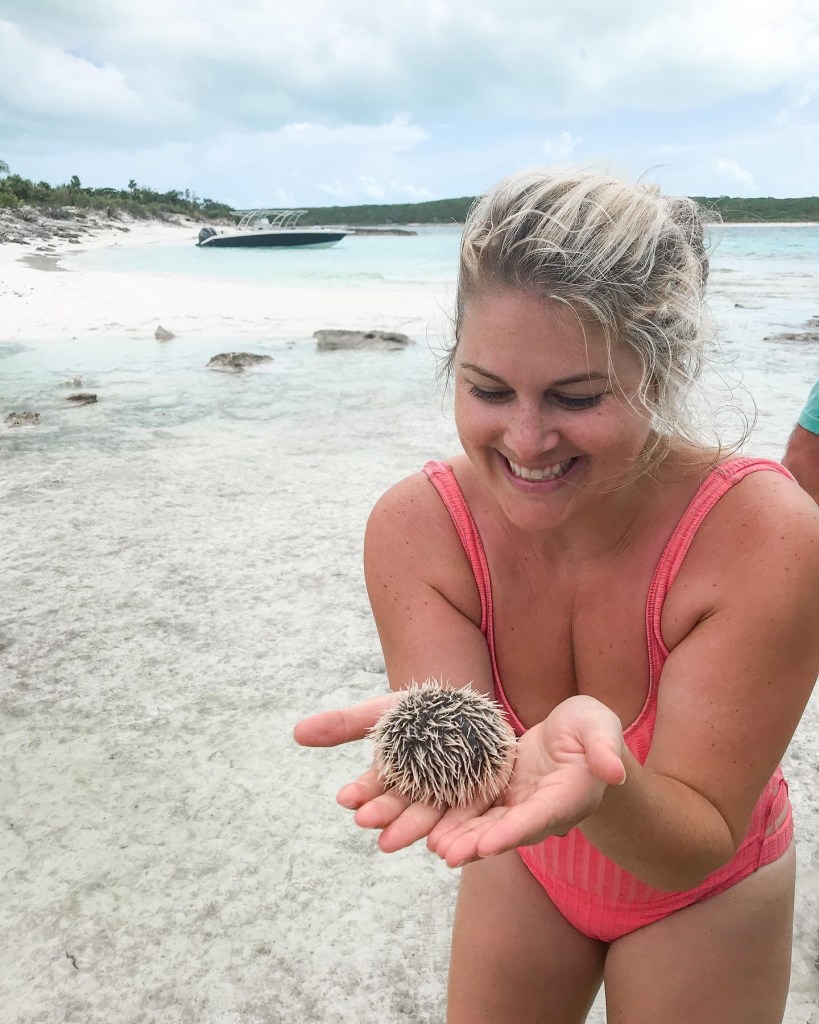
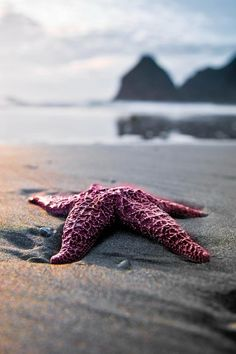
The Search for seashells
The easiest and most obvious things to find in the intertidal zone are seashells. Seashells come from marine invertebrates like molluscs which are animals without a backbone. Instead of a backbone they have a shell which forms an exoskeleton to support their bodies and protect them from predators. They build the shells when they are young using sea minerals like calcium, carbonate and salt. When the animal dies it leaves behind its shell which can often get washed up into the intertidal zone.
Seashell Hunting and Activities
When you stop to look closely for seashells you might be surprised by the variety of species that you can find. The Marine Biological Association have a brilliant free guide to identifying seashells that you can download here to print off and take with you on your adventures. Don’t forget to look closely at the patterns and textures of the shells as well. Often shells that look very similar in shape size and colour have very different patterns which is a good way to work out the species. You can find some fun activity ideas using seashells below.
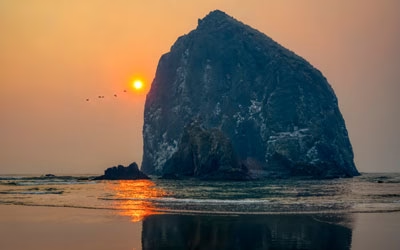
RANKED: The U.S. beaches with the most animal species
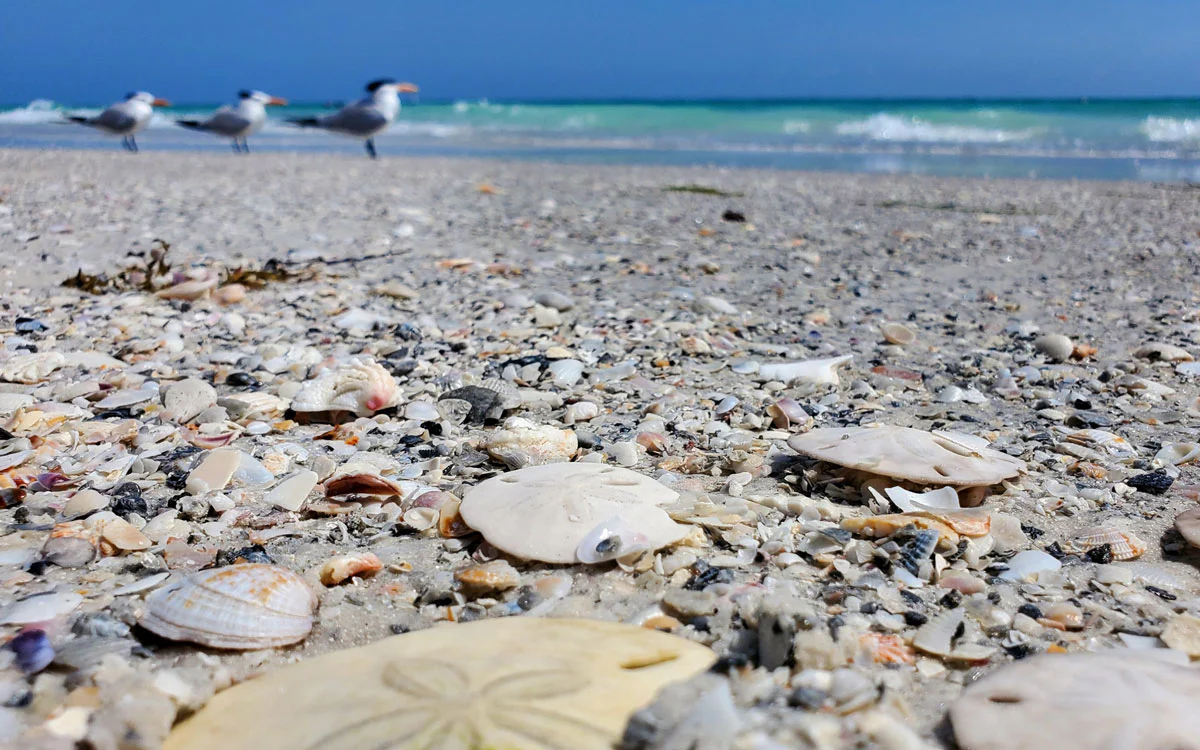
Ethical Shelling
Guidelines for making sure you help protect our shorelines and the creatures that live there.
Go on a sea snail safari
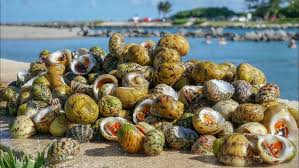
Sea snails can come in all sorts of shapes and sizes and you can normally find them clinging to rocks and other surfaces along the intertidal zone. You might be surprised to find that limpets are a type of sea snail along with periwinkles, whelks and top shells. How about going on a sea snail safari to see how many species you can spot. The Wildlife Trust have great photo guide to identifying sea snails here.
Limpets use their muscular foot (pictured below) to cling tightly to the rocks. They are mainly herbivores and they use a rasping tongue called a Radula (which is one of the worlds strongest biological structures) to scrape algae of the rocks to eat. Limpets sense vibrations if they sense danger they will suction themselves to the rock incredibly tightly in self defence.
Enjoy crabbing
There are more than 4,500 species of crabs in the world, 62 of which live in or around the waters of the UK. However you are most likely to only find the 5-8 most common varieties by the shore. There is great guide to identifying any crabs you find here. *You can also find some fun crab potato print ideas at the bottom of the page.
Like many crustaceans crabs shells are made chitin which is a hard wearing and tough substance. But you might be surprised to know that a crabs blood is actually blue because of the copper it contains. They also have 10 legs not 8 as many people believe. Crabs belong to a group of animals called Decapods which means 10 legs. Lobsters, shrimps, and prawns are also Decapods.
Crabbing is a great activity for children of all ages, they are fascinating creatures to find and there is always a lot of excitement when they scuttle about. You can either hunt for crabs by simply looking in rock pools or under rocks as the tide is going out. Or you can catch crabs in deeper water using a net, a crabbing line (make sure it doesn’t have a hook attached) and some bait. Leftover bacon or bacon rind is the best bait to use as most of the crabs in the UK are omnivorous meaning they eat both animal and plant matter. The best places for crabbing are often well known local spots along shorelines and tidal rivers. You can often can crab off pontoons, bridges, harbour walls, slipways or a jetty.
Please always handle crabs with care and let them go after a short while so they didn’t become too distressed (they blow bubbles when they are stressed). Crabs are often feisty and will pinch you in self defence, so if you want to pick one up its best to gently hold it either side of its shell or carefully pinch the back of crab in between too fingers so it doesn’t get hurt and it can’t hurt you. You can keep any of the crabs you catch in a bucket (filled with water from the location you are crabbing from) for a short while to observe. But remember to change the water or let them go every 10 mins or so, otherwise they won’t have enough air to breath. It’s also best not to overcrowd them as they will fight or become distressed if there are too many crabs together in a small space. You could also add in some seaweed or rocks to give them a bit of shelter to hide in.
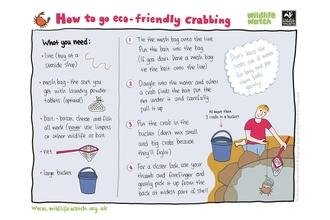
Go crabbing
And respect marine life too!
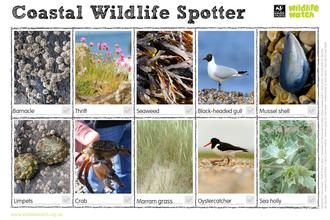
Coastal spotter
Be a nature detective! Can you tick off any of these?
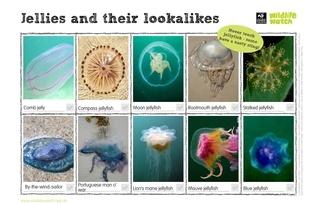
Jellyfish spotter
Be a nature detective! Can you tick off any of these?
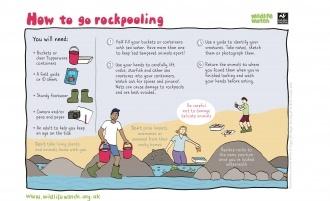
How to rockpool
Meet the wonderful creatures that live in rockpools.
Go rock pooling
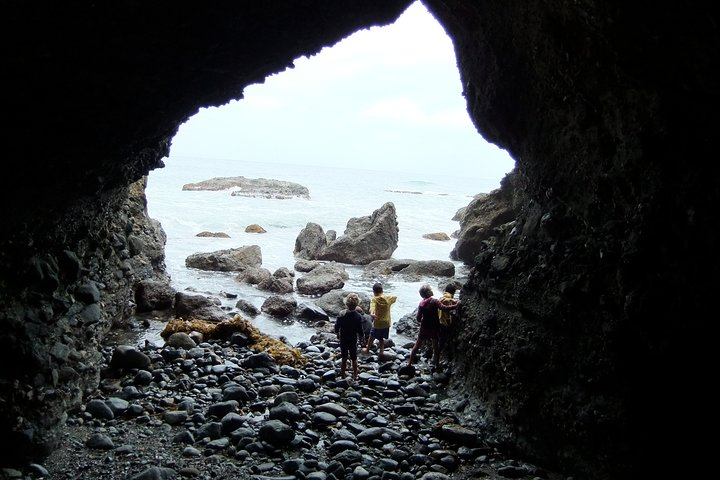
Rock pooling; Whether it is a skulking crab, a delicate star fish or the tentacle blooms of a sea anemone, there is always something to find just below the surface: There is a microcosm of vibrant life that is played out between the tides. One way to discover more about the wildlife that exists along our coast is to spend time rockpooling – whether young or old, exploring beaches and bays can be a truly magical experience.
When the waves have retreated, a whole world emerges at the shoreline
Rock pools are a fantastic place to find a wide array of underwater sea life like goby fish, jelly fish, sea urchins, starfish and sea anemones Any sea anemones you find above the waterline may resemble jelly like blobs. This is because they have folded themselves inwards under a protective layer to shelter from the elements and would be predators.
When they are under water they unfurl their tentacles to catch food, the tentacles have stinging cells which allow them to paralyse prey. Sea anemones are one of the world’s slowest moving creatures, they mostly attach themselves to a surface and remain there. However they are also one of the longest living marine animals and have the ability to clone themselves.
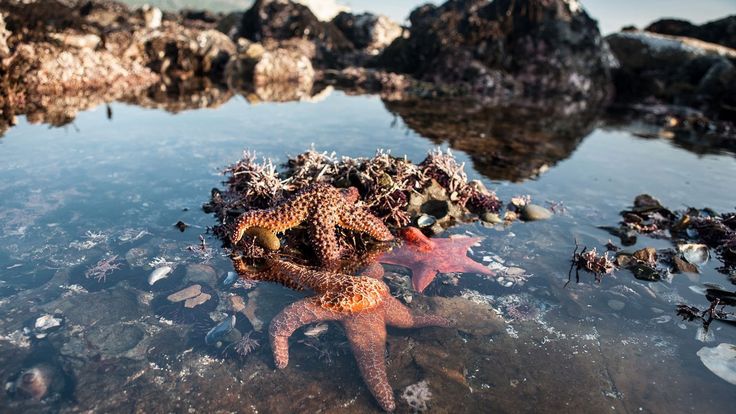
What to look for
Plants and animals that live in rock pools are both fascinating and hardy, surviving a constantly changing environment; fluctuating water temperatures, decreasing oxygen levels, and exposure to sunlight for long periods of time, as well as rough treatment from the incoming sea. Look out for shrimp in the pools, crabs skulking under clumps of seaweed, while starfish cling to the rocks that anchor seaweed. Molluscs, barnacles and anemones sit on the pool floor, and you might see larger creatures like lobster if you’re lucky!Remember to follow the seashore code and handle all wildlife with care. Only keep one animal in a bucket at any one time and make sure to put everything back where you found it.
Try walking along the strand line to see what the high tide has left behind - whether it is seaweed, shells or the distinctive internal shell of the cuttlefish.
If you get lucky you may even spot some jelly fish. The most common jellyfish to find on UK shores is the Moon jelly fish which mostly drifts with the currants feeding on plankton. You can identify them by the four circles on the under side of the dome, these circles are actually the reproductive organs. Did you know that jellyfish don’t have brains, hearts or blood and they are 95% made of water?
Go fossil hunting
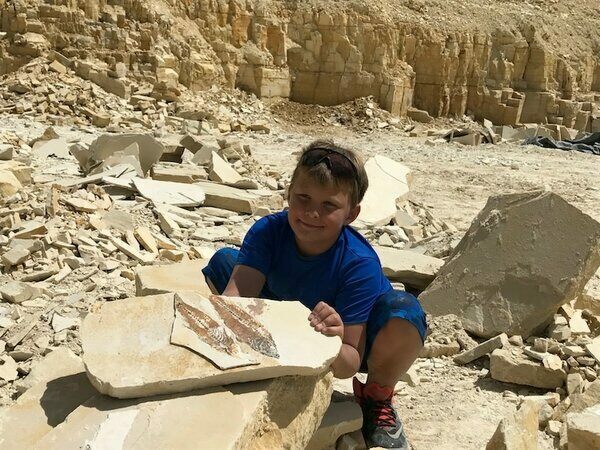
A fossil is the preserved remains, imprints or impression of a once living thing like as animal or plant. Did you know the word fossil comes from the Latin word ‘fossilis’ which meant “obtained by diggin” A good place to find small sea fossils is in flint. Flint forms in layers of chalk and is easy to find in the South of England and Essex, you will often find that most of the pebbles on beaches and gardens in these areas are made of flint. Chalk itself is formed from layers of mud and tiny sea creatures that have died and fallen to the ocean floor.
Over millions of years these layers of mud and sea creatures are compacted into chalk. As the chalk compacts it squeezes seawater containing silica (dissolved quartz) into any cavities, gaps or spaces around it forming nodules and layers of flint. Sometimes the flint nodules forms around a small sea creature or shellfish like a sponge (above) or sea urchin below), preserving them in the flint as a fossil.
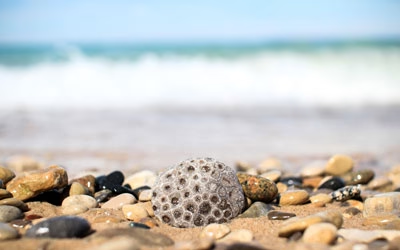
Celebrate National Fossil Day
Some ideas on how to celebrate National Fossil Day any time of the year.
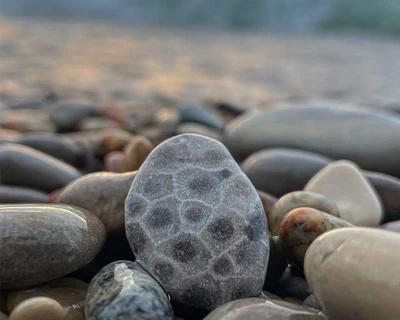
Best beaches for fossils
Where is the best beach for a beachcomber to look for fossils?
Fossilized Urchins
A fossil fanatic, Ramsus collects many different varieties of sea urchin fossils in Denmark.
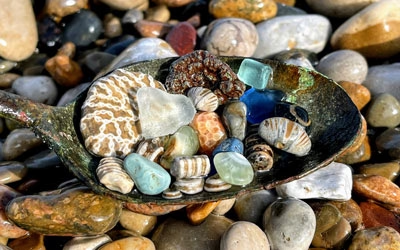
Identifying Fossils on the Great Lakes Shores
The shores of the Great Lakes reveal a diverse array of treasures that wash up, and beachcombing is a favorite occupation of many folks.
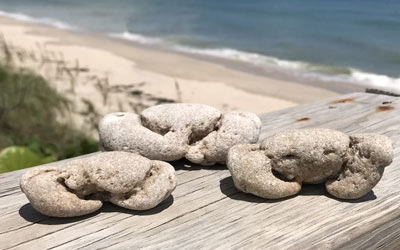
Stone crabs of Satellite Beach
These amazing finds are 110,000-year-old ghost crabs that have been perfectly encased in coquina rock.
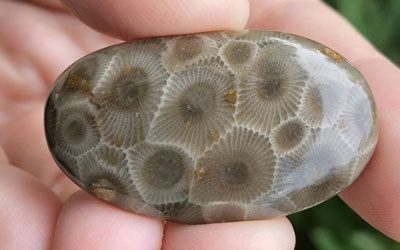
Hidden Beauty: Petoskey Stones
Beachcombers on the shores of the Great Lakes have a chance of coming across Petoskey stones, a combination of fossil, rock, and coral.
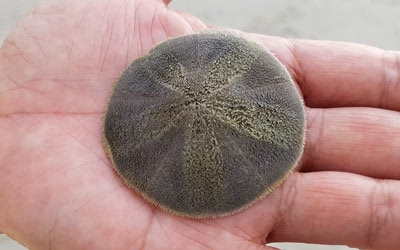
How to Identify Live Sand Dollars
When you take something home from the beach, don't take anything that’s still alive.
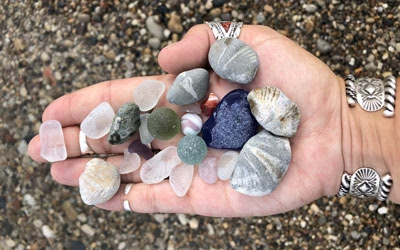
Beachcombing on the Ancient Sea Floor
Fossil shells on Lake Michigan tell a story of a time when the lake was an expansive sea, filled with sea creatures.
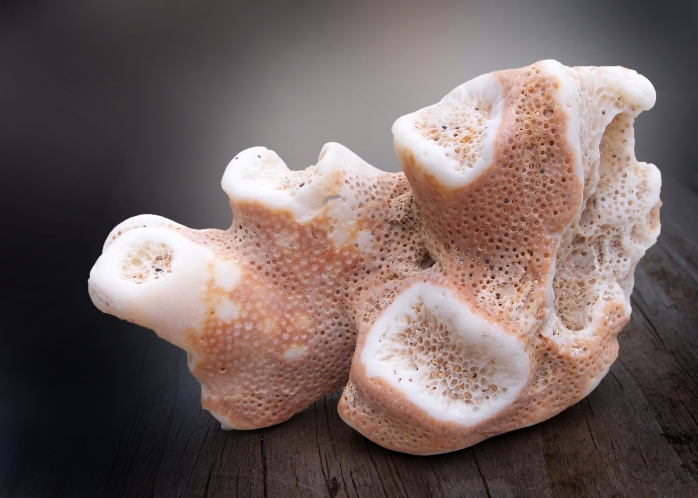
Category of Sea Fossil Facts
Make nature art
Nature art (also sometimes called land art) is a wonderful nature activity that encourages creativity and fine motor skills in children of all ages and abilities. All you need is some imagination and natural materials like pebbles from the shore to create pictures, shapes and patterns with.
Or if you are on a sandy beach you could simply draw and write in the sand, using your fingers or a stick to make patterns and pictures or practising writing skills. Or how about using a combination of materials and marks to make your art.
Make seaweed nature art
Nature art is a great outdoor activity that encourages creativity and fine motor skills. It is also a fun and engaging mindfulness activity. Simply collect as many natural objects as you can find around you. You could use seaweed, sand, stone, driftwood, seashells, leaves, grass, bark, fallen fruit and flowers. *But pretty please don’t pick any wild flowers, only collect ones you have grown yourself or fallen ones you find on the floor. Then arrange them into shapes, pictures or patterns.
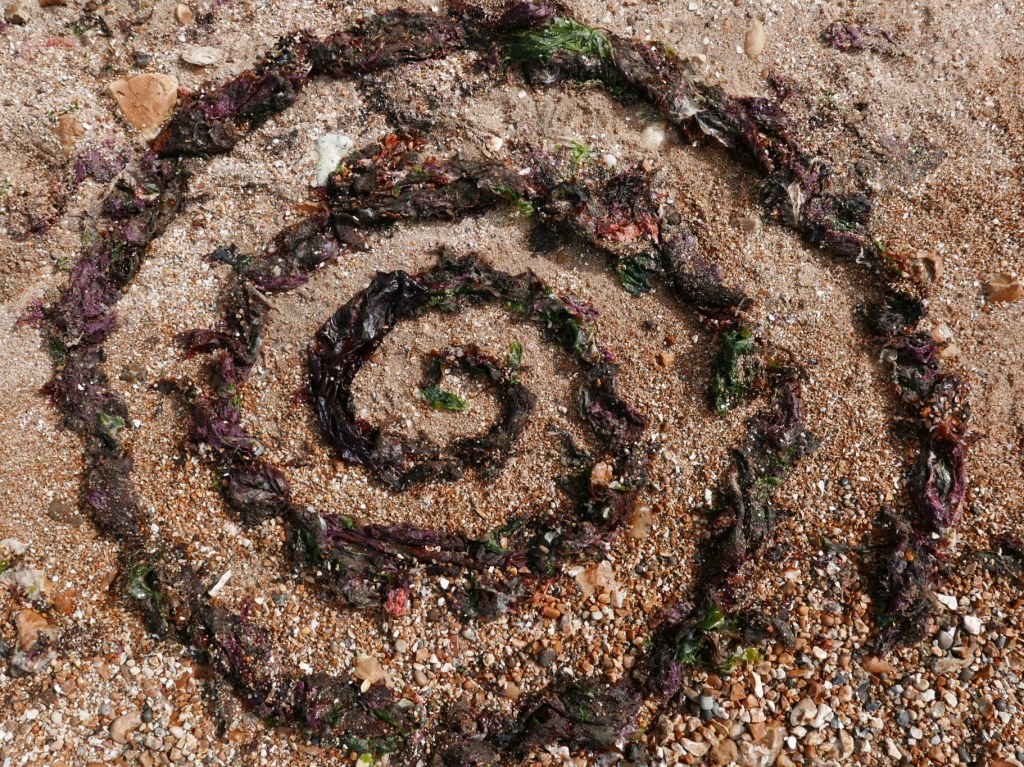
If you take photos of the nature art you create you can then print them out later as artwork, learning resources or even turn them into cards to give to friends and family. You could also make nature art letters, numbers and words to use as learning prompts for English and maths games.
Search for ancient sea glass
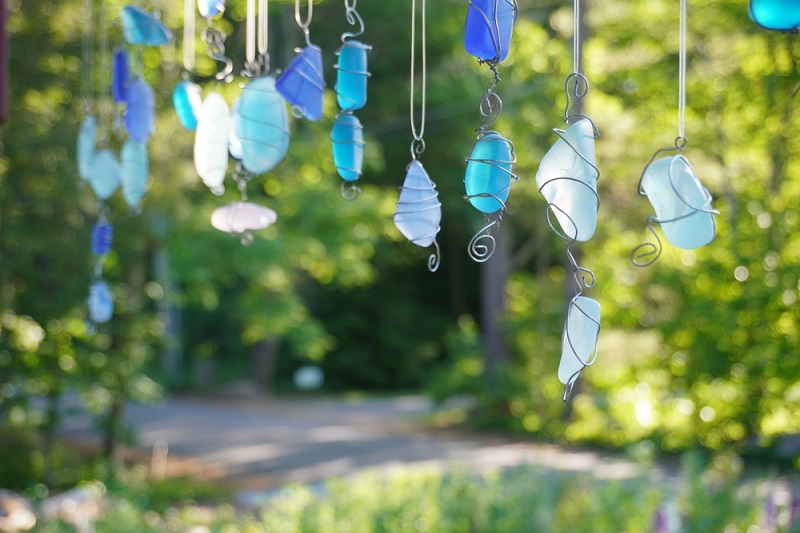
Sea glass is glass that has been weathered an worn down by the sea, a process that can take anything from 20-200 years for the glass to become fully smoothed and frosted by the ocean. The sea glass can come from anything like broken bottles and other rubbish dumped in the ocean to glass windows and tableware from ancient shipwrecks. Safety note: please supervise children when collecting sea glass and make sure they don’t accidently pick up any sharp or newly broken glass.
You can often tell where a piece of sea glass may have come by it’s colour. The most common colours green, brown, white and clear normally come from alcoholic and non alcoholic drinks bottles. Lime green can come from1960’s soda bottles and forest green and soft blues are most likely to be from 19th centaury medicine, ink or soda bottles.
Jade and amber coloured sea glass are more uncommon and are likely to come from old whiskey, spirit and medicine bottles. Other uncommon colours include purple, cobalt and cornflower blues from Milk of magnesia, vicks vapour rub and poison bottles and opaque white which comes from early milk bottles, The rarest colours to find are grey, pink, red, yellow, teal and black. Black sea glass is glass that had iron slag added to it to increases it’s strength and protect liquids sensitive to light damage such as wines. spirits and medicines.
12 Family Beach Games to Have Fun in the Sun
Take Great Photos of Your Kids at the Beach
Want to get your kids doing a little beach-hunting? Print out this Beach Scavenger Hunt before you head to the shore!
Who’s sharing the beach with you?
There is all kinds of wildlife at the beach. Here is a list of some of the most endangered animals you may encounter on your seaside trip.
Sea Turtles
Sea turtles, including the leatherback, Kemp’s Ridley, loggerhead, and green sea turtles, mate, nest, and hatch along the southern east coast of the US and in Baja California. As each of these species is endangered it is vital that their nesting grounds and their reproductive activities are not disturbed. Females nesting turtles are very sensitive to disturbance, and they may abandon their attempt to nest on the beach, and even abort their eggs at sea.
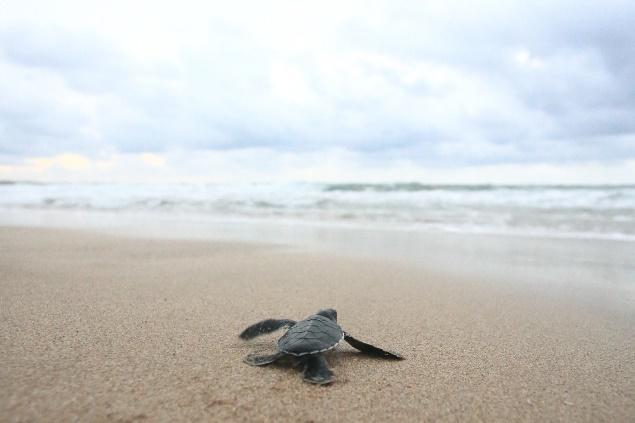
Beach Mice
Healthy beach mouse populations equals healthy dunes. And healthy dunes protect the coast from storms and floods. They are also an important food source for other dune and coastal dwellers. Unfortunately this adorable little seed planter is nearly extinct. Please help protect their habitat by preserving dunes.
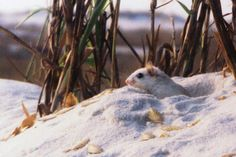
Isopods and other Sand Dwellers
Isopods, known by their popular name roly polies, are tiny nocturnal crustaceans that spend their days burrowed deep in the sand. They come out at night to feed on kelp. They are an extremely important food source for shorebirds. Do to sand grooming, development, habitat loss, and other sand disturbances these once abundant critters are disappearing at alarming rates.
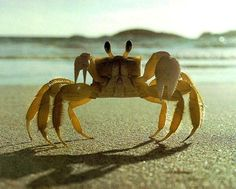
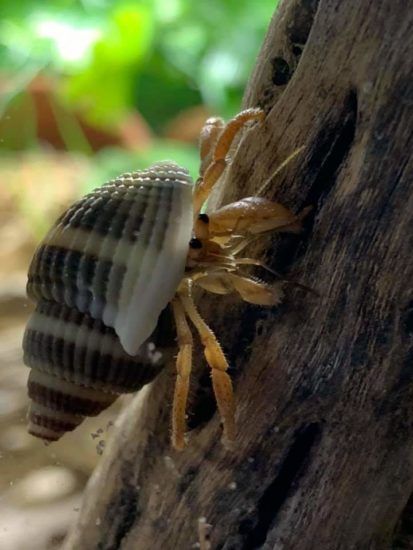
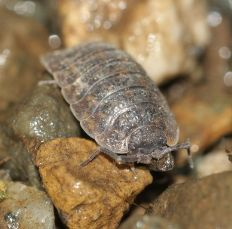
SEALIFE CATCHERS AND VIEWERS
for magnified viewing.
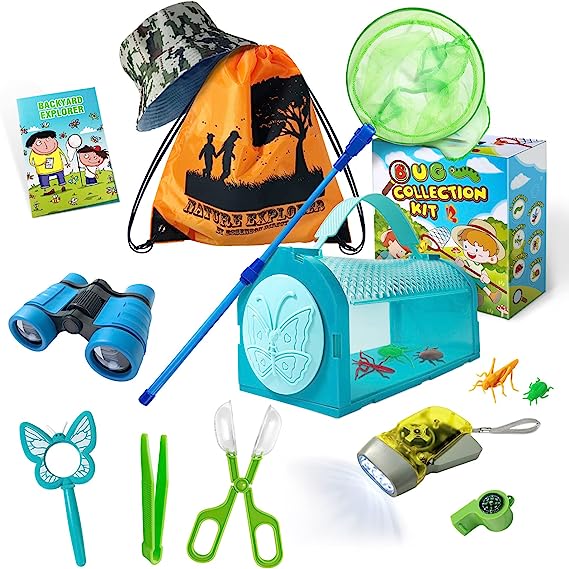
Kids Backyard Critter Catchers Exploration Science and Viewer Microscope – This is a kit that comes with a container with a magnifier for the bugs (or other critters!), a tweezers, and a magnifying glass. My kids had one of these and loved using it in the woods.
Little Backyard Explorer Critter Viewer Collecting Kit (7 Piece) – This kit comes with a bug catcher, multiple containers for holding and observing the insects, two tweezers, and a net.
Fun Insert Bug Viewer Magnifier Backyard Explorer - Viewer Collecting Kit for Children – This is a simple and very inexpensive bug viewer for kids. It has both 3x and 8x magnifying glasses.
Nature Bound Bug Catcher Toy, Eco-Friendly Bug Vacuum – This is a newer version of our family’s favorite – the bug vacuum. It’s perfect for catching, observing, and releasing bugs indoors or outdoors.
Shore and Seabirds
Sea and shore birds. It’s not a trip to the beach without them. Pelicans, cormorants, loons, grebes, gulls, herons, the list goes on. There can be 100 species of shore and sea birds on your beach.
Piping plover and snowy plover are just a few of the endangered birds that use the beaches to nest and feed.
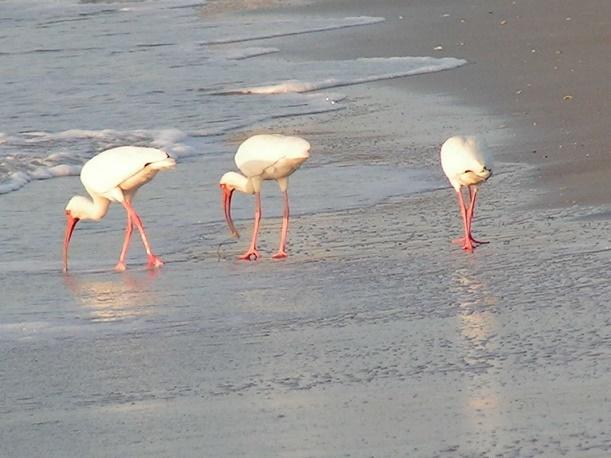
Marine Mammals
Some marine mammals, such as seals and sealions, need the beach to rest, molt, breed, and give birth. They can also be lolling on the sand because they are warming themselves in the sun. I love sharing the beach with the beautiful creatures.
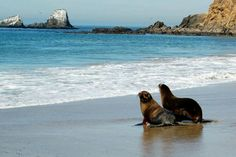
Beach-spawning fish
You are probably not expecting to run into a fish ON the beach. There are a number of fish species that you might run into while your feet are still firmly planted on the shore. Grunions are the most famous beach spawners, but there are many species of smelts (Osmeridae) and silversides (Atherinopsidae) that leave the water to mate and lay their eggs. This unique breeding process leaves both the mating fish and the eggs, which develop deep in the sand at the shoreline, incredibly vulnerable.
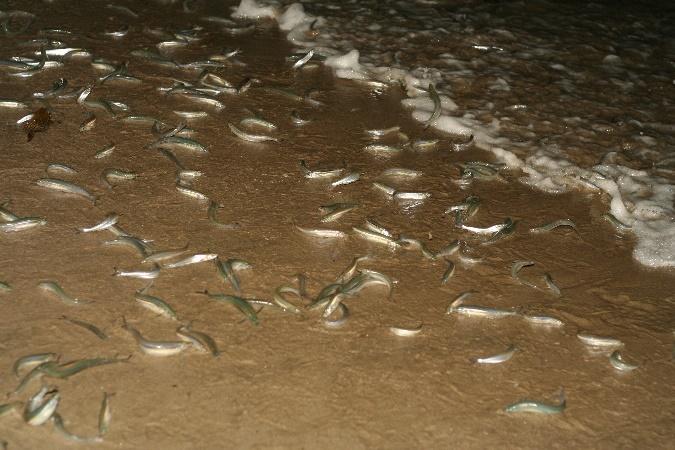
Know who’s there
Each beach is its own ecosystem and residents and visitors. The best way to share the beach is by learning what kinds of wildlife live, feed, and reproduce on your beach.
Do not disturb
Who doesn’t love to watch their kids or dog chase a flock of shorebirds into the sky?
And who wouldn’t jump at the chance to see a sea turtle nesting? Sometimes the most seemingly harmless activities are very stressful and disruptive to the animals who live, reproduce, feed, and travel on the coast. Avoid disturbing animals, particularly when they are reproducing or feeding.
How to tell if a sea shell is alive or dead.
If a bivalve shell is intact, and both halves are tightly closed together, then there is still a living creature inside.
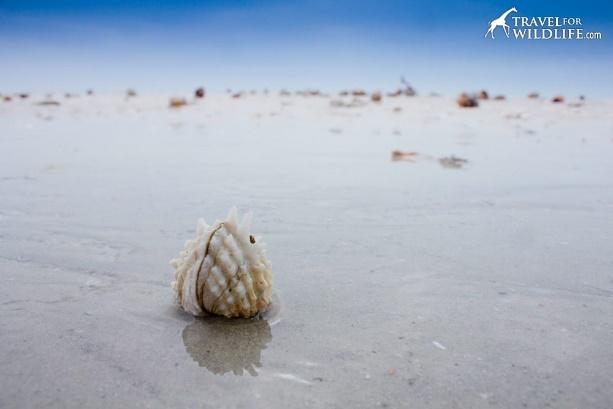
How to tell if a bivalve sea shell is alive. If the two halves of the shell are tightly closed together, like this Spiny Jewel Box, then it is alive!
You may also encounter living bivalves with their shell open that may be feeding in shallow pools or stranded by storms. If you touch them and they close their shell, then of course they are alive!
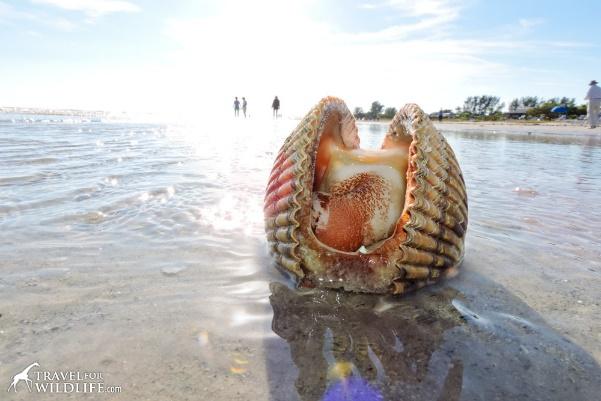
If you find a bivalve shell open, it may still be alive like this Cockle. If you touch it and it closes then it’s definitely alive!
If you’re not sure then err on the side of caution and place it gently back in the sea.
With spiral shells simply look inside! If you see anything in there, whether it’s the original mollusk or a hermit crab tucked deep inside, then it’s probably alive. Feel free to return it gently to the ocean! (Though if it smells really horrible then it’s probably dead.)
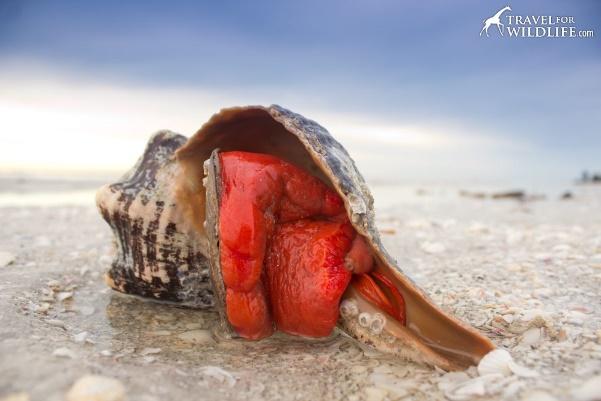
How to tell if a spiral sea shell is alive or dead. If you see any animal inside, it’s probably alive. If it’s moving like this Horse Conch then it’s definitely alive!
Many mollusks that live in spiral shells have what is called an operculum. It’s like a hard flat door that they use to close themselves tightly into their shell. If you seen an operculum blocking the entrance, then there is a living animal inside! If you’re not sure, leave it be.
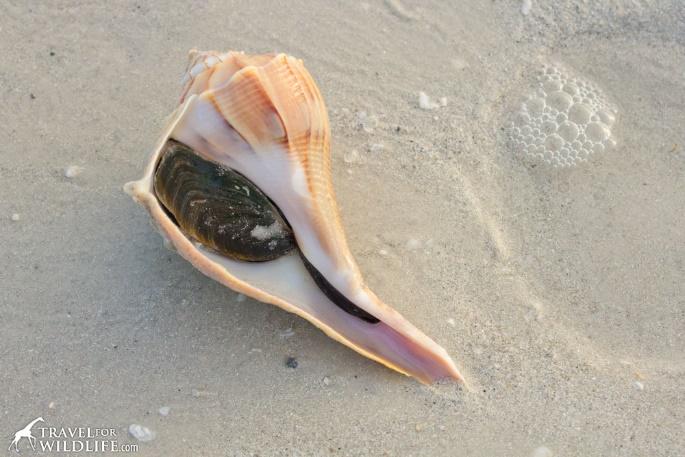
How to tell if a spiral shell is alive. If there is a “door” closing the shell (the operculum) like this Lightning Whelk, then it is alive!
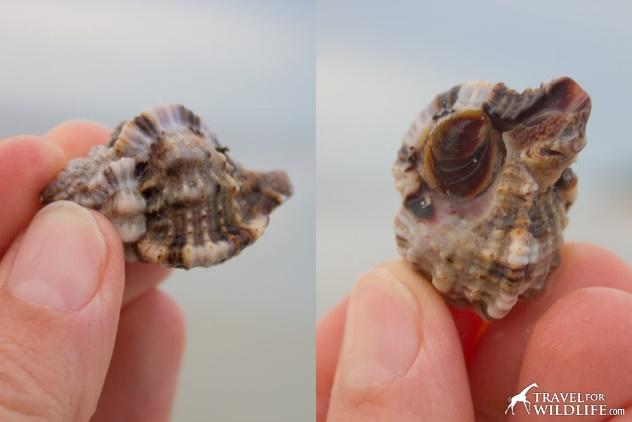
You can tell this Apple Murex shell is alive because the operculum (the tiny “door”) is tightly blocking the opening.
For more great eco-friendly shell collecting ideas, be sure to read our article A Guide To Ethical Shell Collecting!
Check out this photo gallery:
The Living Shells: A Photo Gallery of Sanibel Island Seashore Creatures.
Preserving Beach Collectables
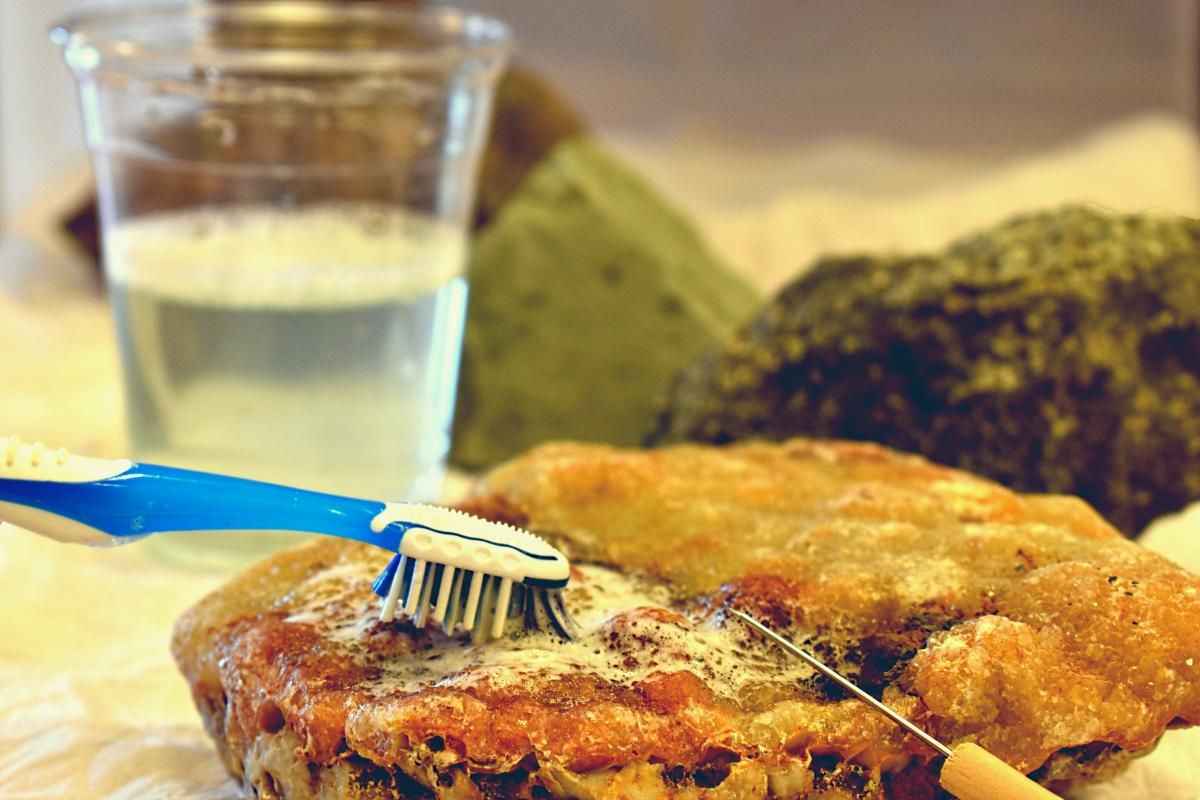
Basic Rock and Mineral Cleaning
at Home
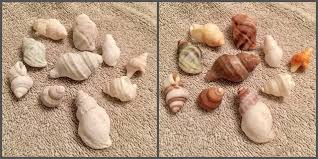
Preparing and Sealing Seashells
To clean and prepare beach shells, begin by giving them a rough rinse in soapy water to remove loose dirt, then soak them in a 50/50 bleach and water solution for several hours to remove odor, algae, and a protective outer layer called the periostracum.
After the soak, rinse the shells and let them dry completely. For stubborn deposits, use a stiff toothbrush or wire brush, or for a glossy shell that has become dull, consider a quick dip in an acid solution like muriatic acid, though this is not recommended for all shells. Finally, to restore shine and color, apply a thin coat of mineral oil or baby oil with a soft cloth.
1. Rough Cleaning
Materials: Water, dish soap, a large bowl.
Process: Rinse your shells in a bowl of soapy water to remove any large pieces of dirt or sand.
2. Bleach Soak (for Odor and Debris)
Materials: Bleach, water, a bucket, a toothbrush.
Process: Mix a 50/50 solution of bleach and water.
Soak: Submerge the shells in the solution for several hours, or even a day, to sanitize them, remove organic matter, and eliminate unpleasant smells.
Note: Avoid this step for shells with a natural, high-gloss finish, as bleach may dull their natural shine.
3. Thorough Cleaning and Drying
Process: Remove the shells from the bleach solution and give them a final rinse with clean water.
Dry: Allow the shells to air-dry completely on a towel or newspaper.
4. For Dull or Cloudy Shells (Optional, use with caution)
Materials: Muriatic acid, water, a glass container, tongs, a wire brush, baking soda.
Process: Mix a solution of 1 part muriatic acid to 2–3 parts water, always adding acid to water first. Wearing gloves and working in a well-ventilated area, dip a shell into the acid solution for only a few seconds. You will see "fizzing" as the acid attacks calcium deposits.
Safety First: Muriatic acid is dangerous. Wear protective gloves and eye protection and ensure the area is well-ventilated.
Rinse and Neutralize: Immediately dip the shell in fresh water, then place it on a towel to dry. When finished, neutralize the leftover acid by mixing it with baking soda until the bubbling stops before disposing of it safely.
Alternative: For less intense cleaning of calcified shells, try a diluted solution of hydrogen peroxide or a product like CLR (Calcium, Lime, and Rust Remover).
5. Polishing for Shine
Materials:
Mineral Oil for Natural Shine:.For a subtle, natural look that restores color and adds a slight gleam, apply a bit of mineral oil with a soft cloth. Buff it in and allow it to dry.Clear Spray for a "Wet" Look:.A satin-finish polyurethane or a similar clear coat spray provides a protective barrier that intensifies the shell's colors and gives them a vibrant, "wet" appearance. Do this in a well-ventilated area and apply coats to both sides, allowing them to dry in between.
Nail Polish for Quick Shine:.Clear nail polish is a simple and quick way to give shells a beautiful, deep shine and a protective finish.
Varnish for Extra Gloss:.A glossy varnish, such as the one from Vernidas, will give shells a very shiny, glassy finish.
Process: Once the shells are completely dry, apply a few drops of mineral or baby oil to a soft cloth.
Shine: Rub the oil onto the shell's surface to bring out its natural color and give it a beautiful sheen.
Cleaning Fragile Coral and Sand Dollars From the Beach
To clean beach coral, you can gently scrub it with a toothbrush and water, let it sit in the sun to bleach naturally, or use a diluted bleach solution .For the bleach method, ensure the coral is rinsed thoroughly and allowed to air dry to remove any residual chlorine, or soak it in RO (reverse osmosis) water with a dechlorinator to neutralize the bleach.
A safer, natural alternative is to soak the coral in 3% hydrogen peroxide and place it in the sun to lighten it over several days.
Method 1: Gentle Scrubbing & Sunlight
Scrub: Use a new, dedicated toothbrush to gently scrub the coral in plain water to remove loose debris and algae.
Sunlight: Place the coral in a sunny spot for several days to allow the sun to naturally bleach it.
Rinse: Rinse the coral thoroughly with water after the sun exposure.
Method 2: Diluted Bleach Solution
Prepare solution: In a bucket, mix a diluted household bleach solution (e.g., one part bleach to three parts water).
Soak: Place the coral in the solution.
Scrub: Use a toothbrush to gently scrub the coral, being careful not to damage its delicate structure.
Rinse & Neutralize: After soaking for several hours to a day, drain the bleach solution. Rinse the coral thoroughly with water. For added safety, you can soak it in a bucket of reverse osmosis (RO) water and add a water conditioner to remove any lingering bleach odor and neutralize the chlorine.
Air Dry: Allow the coral to air dry completely.
Method 3: Hydrogen Peroxide
Prepare solution: Submerge the coral in a solution of 3% hydrogen peroxide. You may need multiple bottles to fully cover the coral.
Soak & Sunlight: Let the coral soak for a period, then remove it and place it in a sunny area for a few days to complete the bleaching process.
Rinse: Rinse the coral well after the hydrogen peroxide soak.
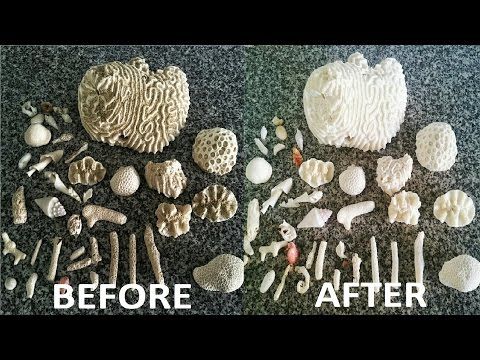
Important Considerations
Gentleness: Coral is fragile; be gentle when scrubbing to avoid breaking it.
Bleach Residue:If using bleach, it's crucial to remove all traces of it, as residual chlorine can be harmful, especially if you intend to put the coral in an aquarium.
Algae:Remember that once cleaned, the coral will eventually develop new algae growth over time.
Vinegar: Avoid using vinegar to clean coral as it can break down the calcium carbonate structure of the coral.
Harvesting And Cleaning Seaweeds
Through the summer we mostly found red seaweed, in autumn and winter, we see more green and brown.
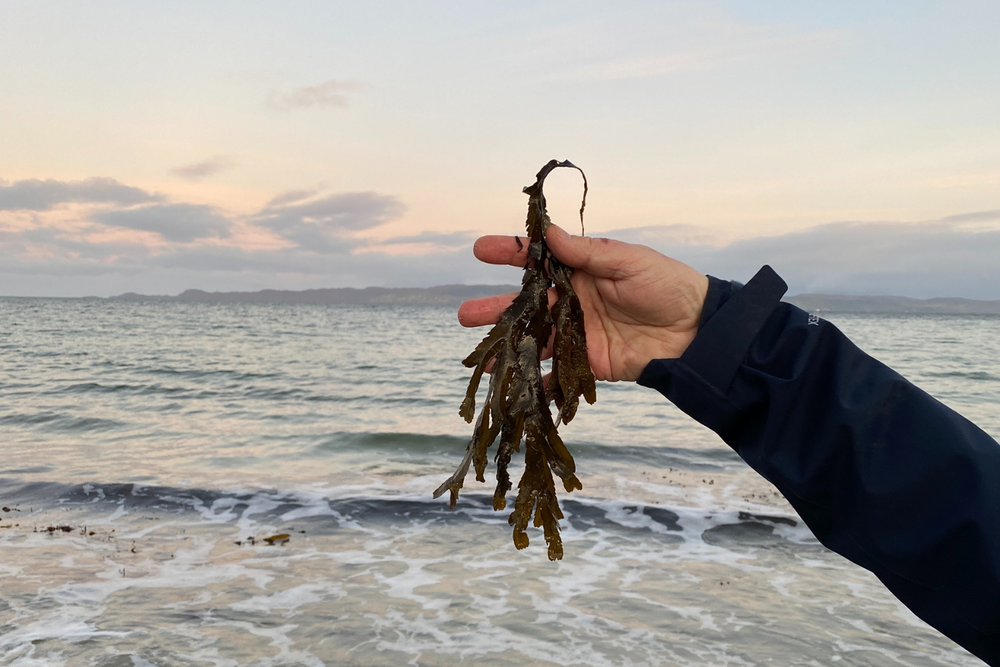
How and When to Collect Seaweed from the beach
Low tide is the perfect time for collecting seaweed specimens as there will be a selection washed up on the beach, you can check the tide times for your local beaches, only collect the seaweed which is unattached rather than taking live seaweed which is attached to rocks.
Fill your buckets or zip bags with the best seaweed you can find and include some seawater to prevent them from drying out whilst you get them home.
To prepare seaweed for crafts, you need to clean it thoroughly and then dry it, most commonly by pressing it flat. This process is ideal for creating frameable art, cards, or scrapbook embellishments.
Step 1: Collect your seaweed
Where to find it: Collect unattached seaweed that has washed up on the shore during low tide. Avoid taking living seaweed that is attached to rocks.
What to look for: Seek out interesting colors and delicate, lacy, or full-branched specimens. The translucent and more delicate types often produce the best pressings.
How to transport it: Bring a bucket or sealable bag and include some seawater to keep the specimens fresh and from tangling on the way home.
Step 2: Clean the specimens
Rinse: Gently wash the seaweed in cool, fresh tap water to remove any sand, salt, and marine life. Be careful to avoid damaging the more delicate pieces.
Soak: Put the rinsed seaweed into a shallow tray filled with about an inch of clean, cool water. This will keep it pliable for the next step.
Step 3: Arrange and press the seaweed
Prepare your work surface: Submerge a sheet of heavy watercolor paper in the tray of water. This heavy paper is durable and can withstand being wet.
Float and arrange: Place a piece of seaweed onto the submerged paper. Using a small paintbrush, tweezers, or chopsticks, gently spread the branches and arrange the seaweed into a pleasing, natural-looking composition. Patience is key for this step.
Lift and drain: Carefully lift the paper out of the water, tilting it to let the excess water drain off without disturbing your design. You can make small adjustments with a wet paintbrush if needed.
Dry and flatten: Place the wet paper with the seaweed on top of several layers of newspaper or cardboard.Cover the seaweed with a piece of fine synthetic mesh fabric or waxed paper to prevent it from sticking to the next layer.Add more absorbent layers, such as newspaper or paper towels, and then a final piece of cardboard.Place heavy books, bricks, or a plant press on top to apply even pressure.
Change the papers: Replace the wet newspapers and towels daily for the first few days to prevent mold.
Cure: Leave the press alone for several weeks to allow the seaweed to fully dry and cure.
Step 4: Finalize your craft
Remove: Once completely dry, remove the weights and carefully peel back the cover sheet. The seaweed will be naturally adhered to the paper.
Display: For a clean finish, place your pressed seaweed art in a frame under glass.
Use in projects: If any edges are loose, you can secure them with a dab of glue. Use your pressed seaweed to decorate cards, journal pages, or other mixed-media projects.
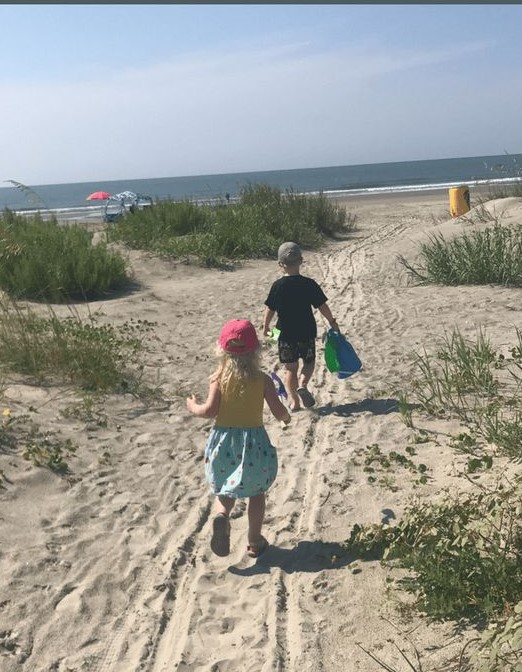
THINGS TO MAKE OR DO
It’s so easy to create this At the Beach Nature Sensory Bottle. It makes a great memento of a tropical or beach vacation too. You can gather the items while on holiday and bring the bottle home with you to remember the trip by.
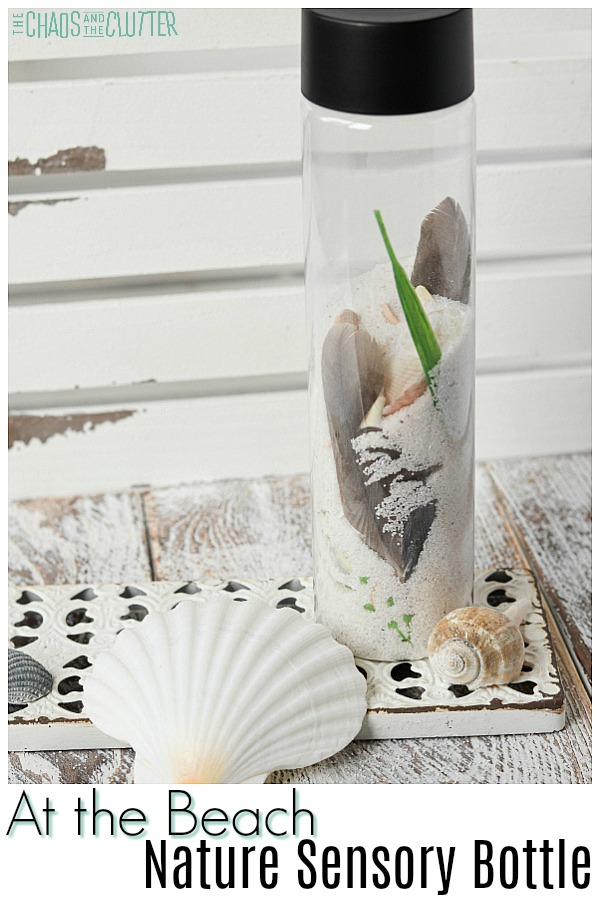
I love that this discovery bottle uses things found in nature. Just like our Seashell Fossils in Playdough activity, this allows kids to explore using their senses and items they found themselves.
At the Beach Nature Sensory Bottle:
Supplies:
empty water bottle (I like the look of Voss bottles, but you can also purchase these empty sensory bottles)
seashells
sand
seagull feathers
seaweed or beach grass (FYI-Some of the more delicate seaweeds will change color and turn to powder from the abrasive nature of the sand. So becareful to use the more hefty seaweed options)
optional: super glue to seal the bottle cap
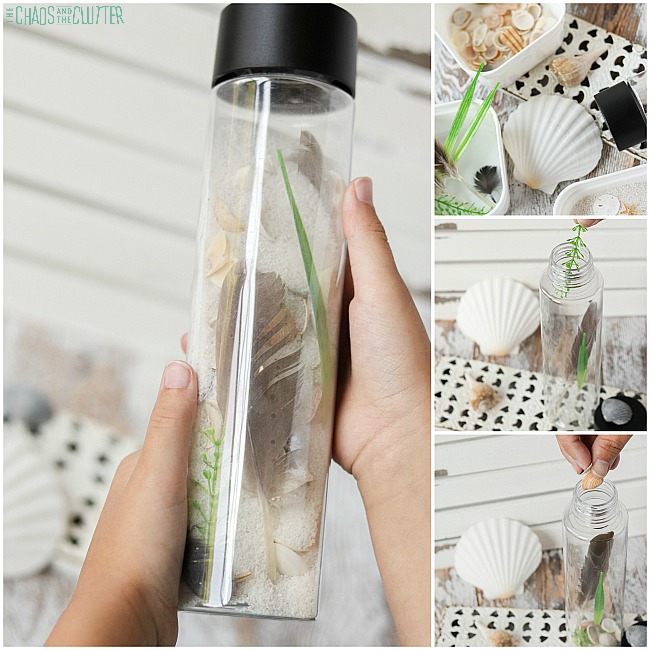
Directions:
Take a walk on the beach to collect the items you want to include in the sensory bottle.
Wash the items (other than the sand) and lay them out on paper towels to dry. Be sure they are fully dry before adding them.
Pour sand into the bottle until it is 1/4 to 1/3 of the way full. You can use a funnel to make this easier.*
Drop in small seashells, small sand dollars, seaweed, and feathers. You could also add small driftwood or rocks found on your walk.
*If you are on vacation and don’t have a funnel with you (because who brings a funnel on vacation?!), you can roll up a piece of paper into a funnel and pour the sand through that.
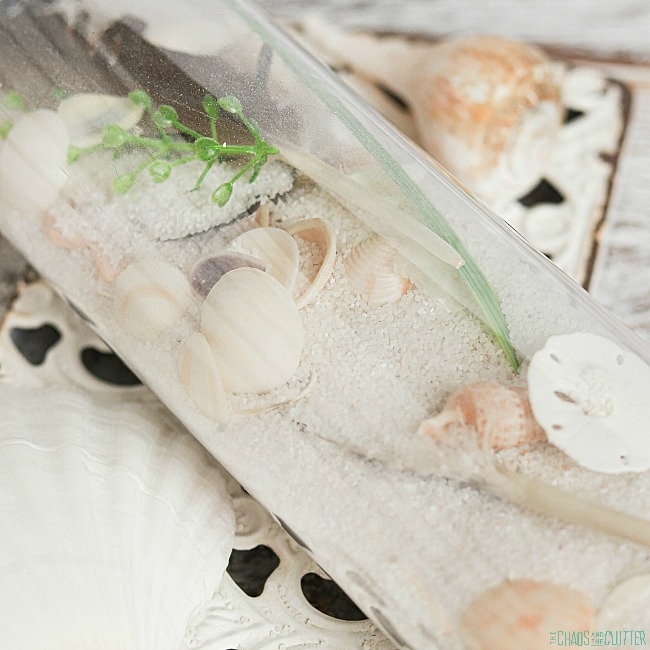
You can keep your creation as a keepsake from your vacation. You can use a permanent marker to write the location and year on the bottle and display it in your home.
Sensory and Learning Opportunities:
Sensory: This sensory play activity begins with the walk along the beach. The feel of the sand under their feet, the wind on their skin, the sound of the waves, the smell of the sea all engage the senses.
The experience continues with adding the collected items to the bottle. This beach sensory bottle involves the visual and tactile sensory systems and during the walk, the olfactory and auditory systems.
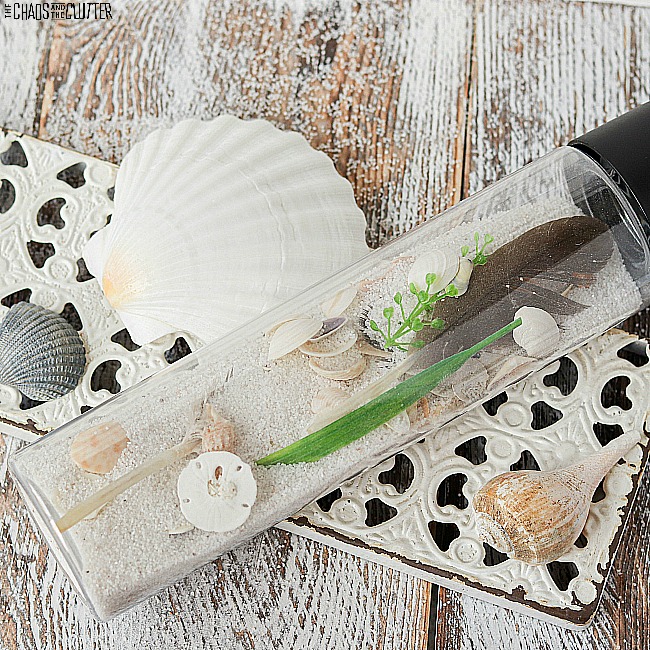
Science: This activity encourages children to explore the world as they get up close to the beach. You can expand on what they learn by providing books about sea life and seashells so that they can discover what animals lived in the shells at one time.
Suspended Liquid Based Nature Sensory Bottle
The sensory input on this activity happens throughout the activity. Each individual nature sensory bottle is unique.
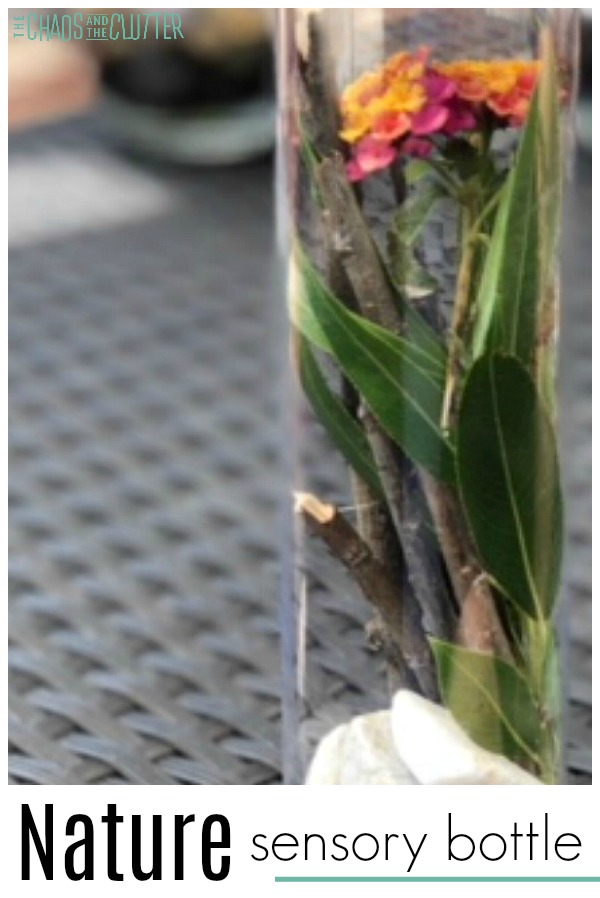
Begin with a trip to a beach or fresh water shoreline to explore nature. Bring a plastic water bottle with you. Allow your child to really take the lead on this walk or hike.
If they find things that catch their eye, they can add them to their sensory bottle. They can either gather all of the items before and add them to the bottle later or they can add the items as they find them.
My kids really enjoyed creating their nature sensory bottles. They enjoyed running and exploring the different terrains and habitats near the water as they were looking to discover items to include. I love how each one of their bottles of their came out so differently and yet all were lovely.
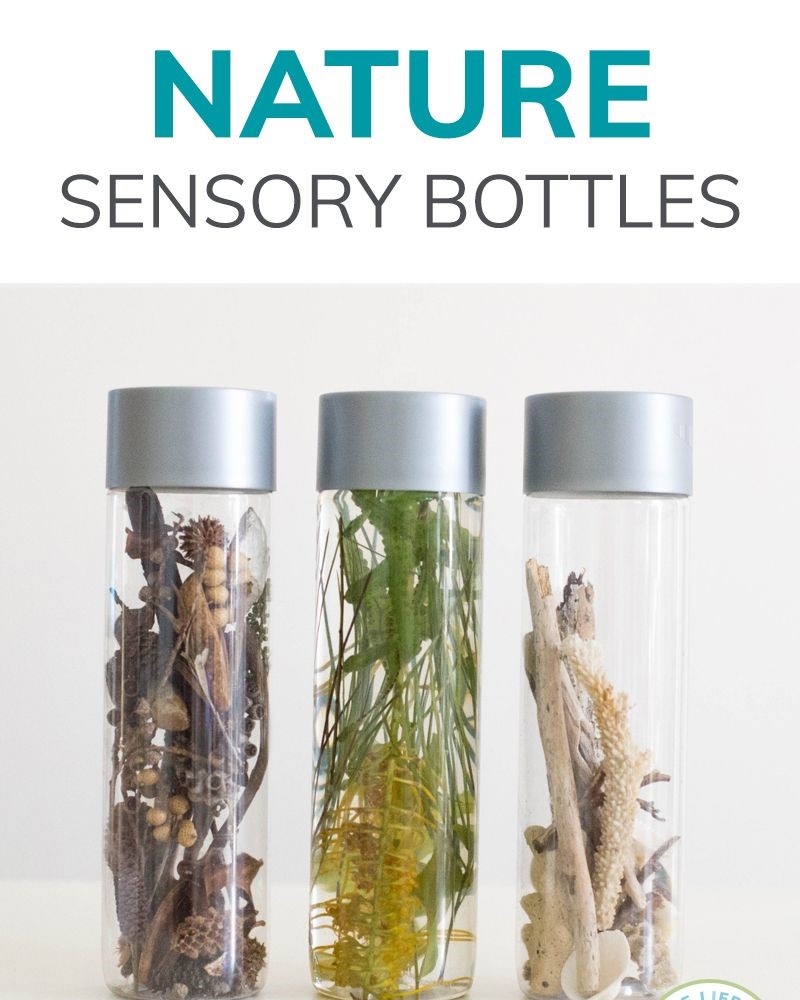
Making Your Nature Sensory Bottle
Materials needed:
empty water bottle (I like the look of Voss bottles)
items found on the beach like shells, rocks, sea glass, seaweed, sand, drift wood, coral and more
Liquid of choice to suspend the beach treasures in
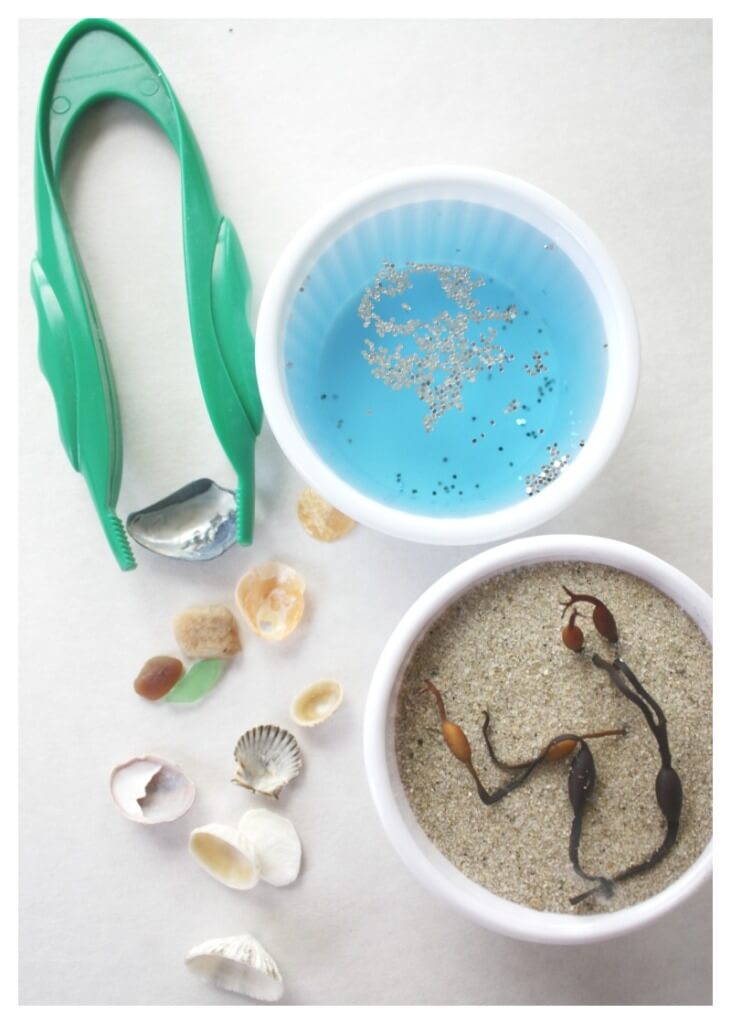
As they gather items to fill their bottle, have them describe the items to you. See if they can incorporate their senses into the descriptions.
Really, any item they find can be added to the sensory bottle, so this list is not comprehensive.
When complete, place the lid on the bottle. Some of the items in these sensory bottles can mold over time due to moisture, so the bottles only keep for a few weeks. Or you can fill the bottle up and empty it right away and head back out on another nature hike to fill it again.
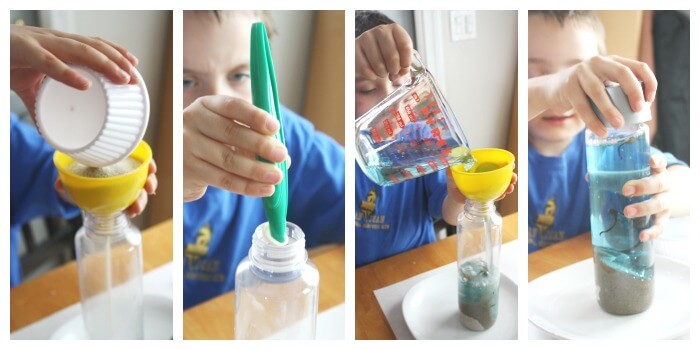

Other sensory play ideas using things found in nature:
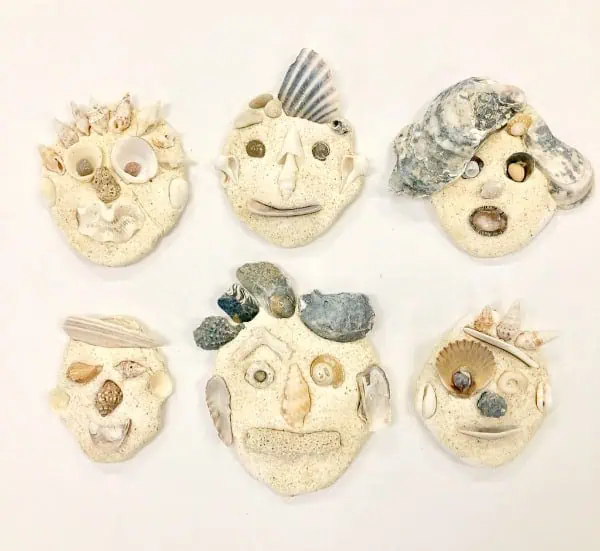
activities for the whole family!
Embrace the beauty of the ocean and bring it into your home with these enchanting creative art activities.
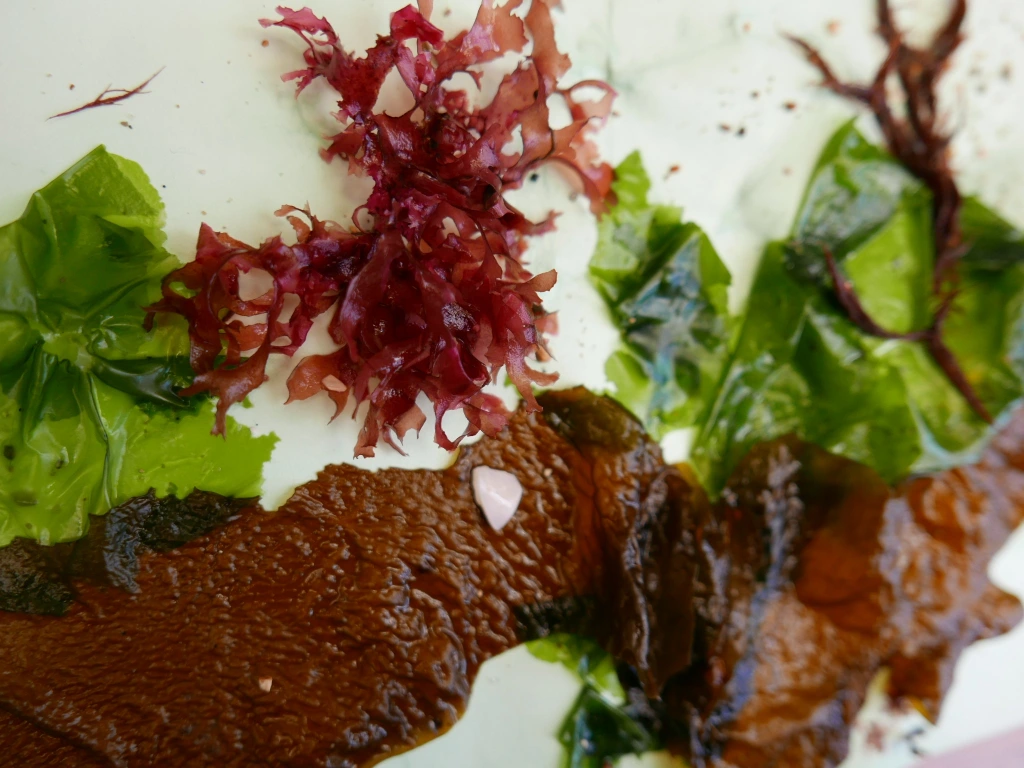
Seaweed Activities
Kids Crafts for the Beach
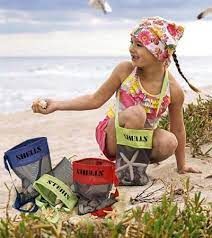
1. Shell Collecting, Sorting, & Arranging
Chances are you and your kids already collect seashells when at the beach. This is one of those simple activities that we all seem to be drawn to.
While some might hold out for the perfect (whole) shells or the rarer specimens, most kids are just as excited about the common shells and shell fragments they come across. Wash the shells off, sort them by type, arrange them by color or shape, trade them, whatever you’d like!
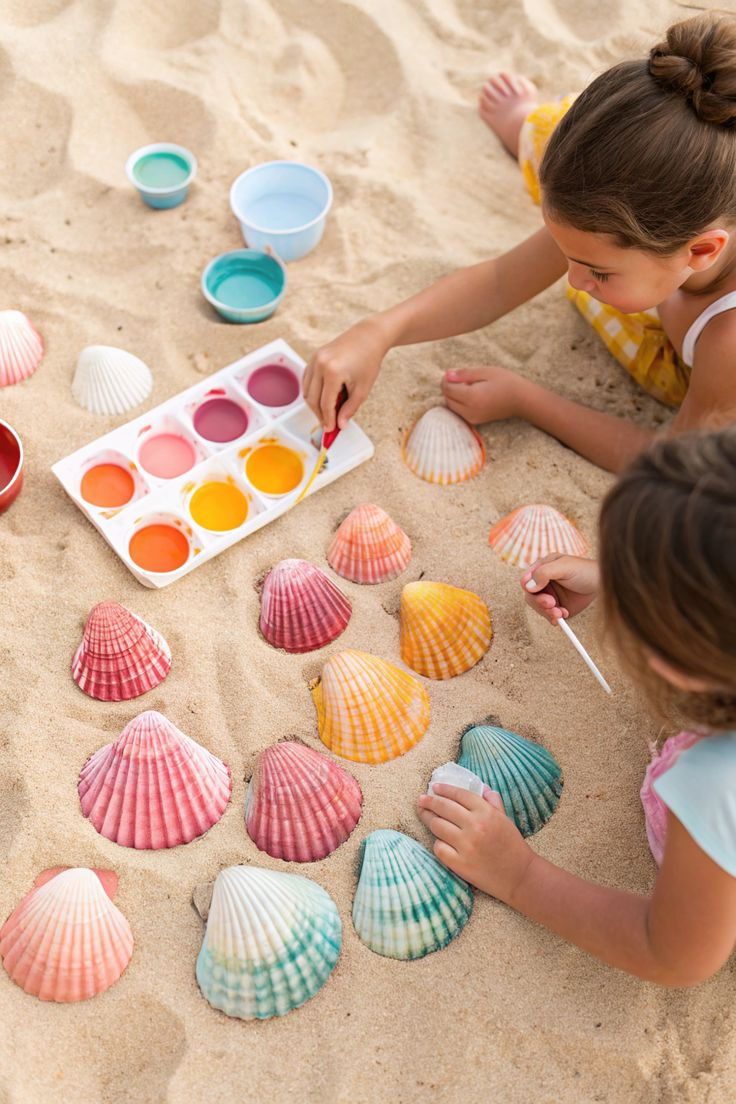
2. Paint Shells
If you bring any shells home, you can paint them! We’ve done this with both tempera cakes and BioColor Paint and they are both great for adding color to your shells.
Not near a beach? You can purchase inexpensive shells and have your very own beach art day wherever you are!
Photo by Andrea Martelle
3. Melted Crayon Shells

We’ve made plenty of melted crayon rocks but seashells are even more fun! They look like special treasures when you add the color and set them out in the sun. The sun melts the crayon
You can also try this with oil pastels on unheated shells. It’s a good option if you don’t want to work with hot shells.
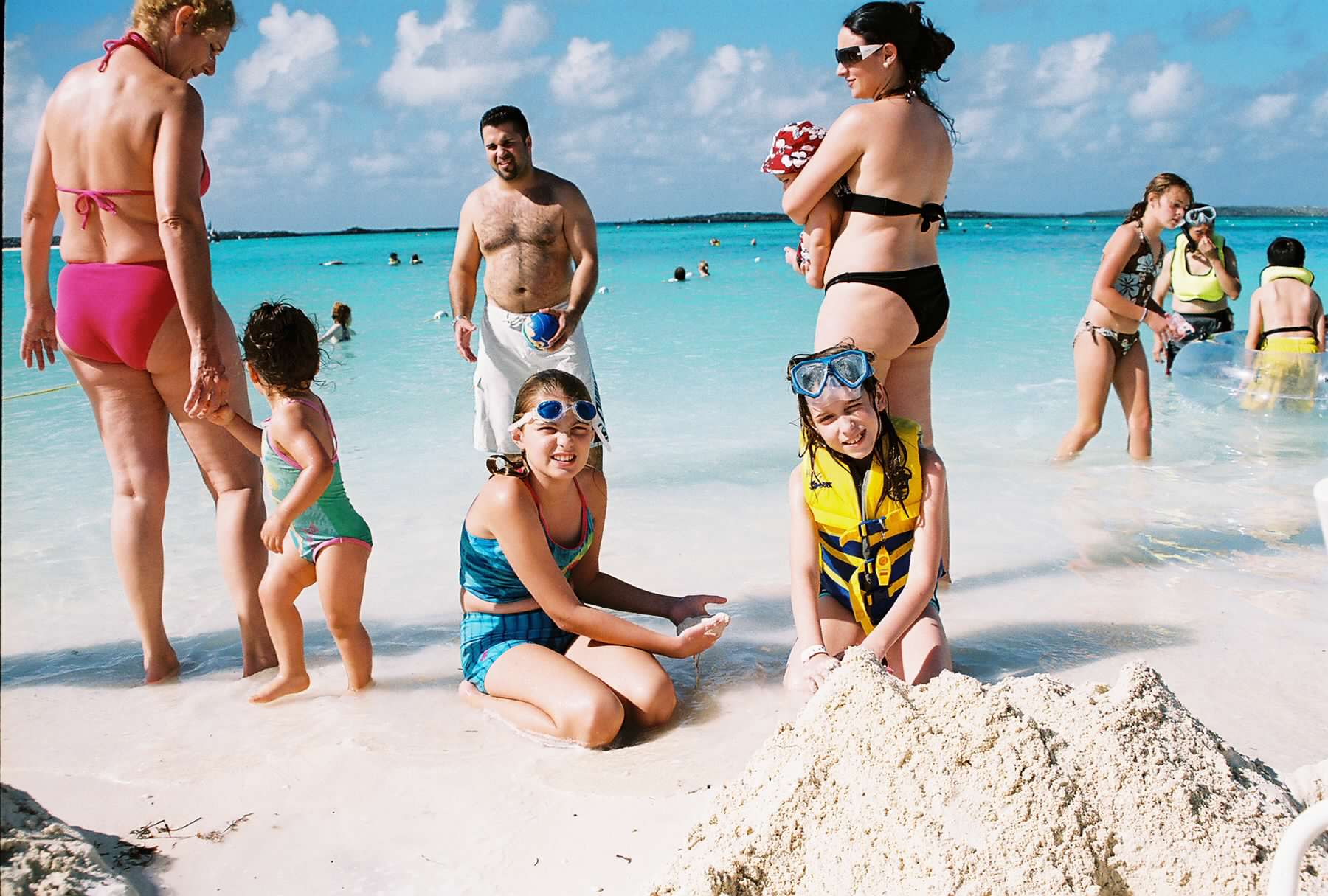
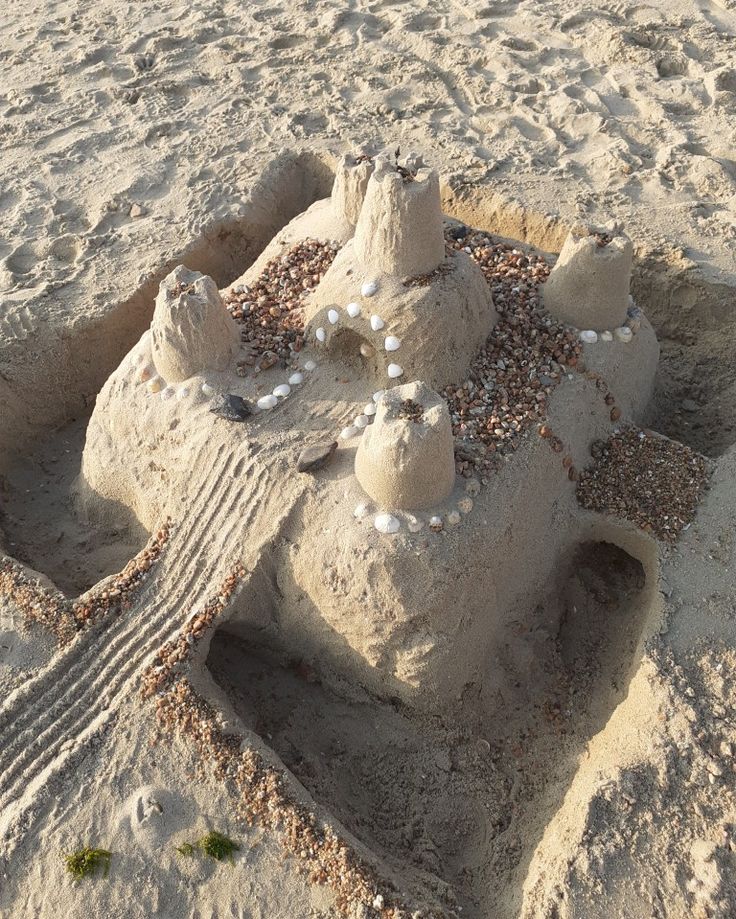
4. Building Sandcastles
Of course! The beach is one giant sandbox and water play table combined, enticing us to shape and mold it into structures that will last just until the tide comes in.
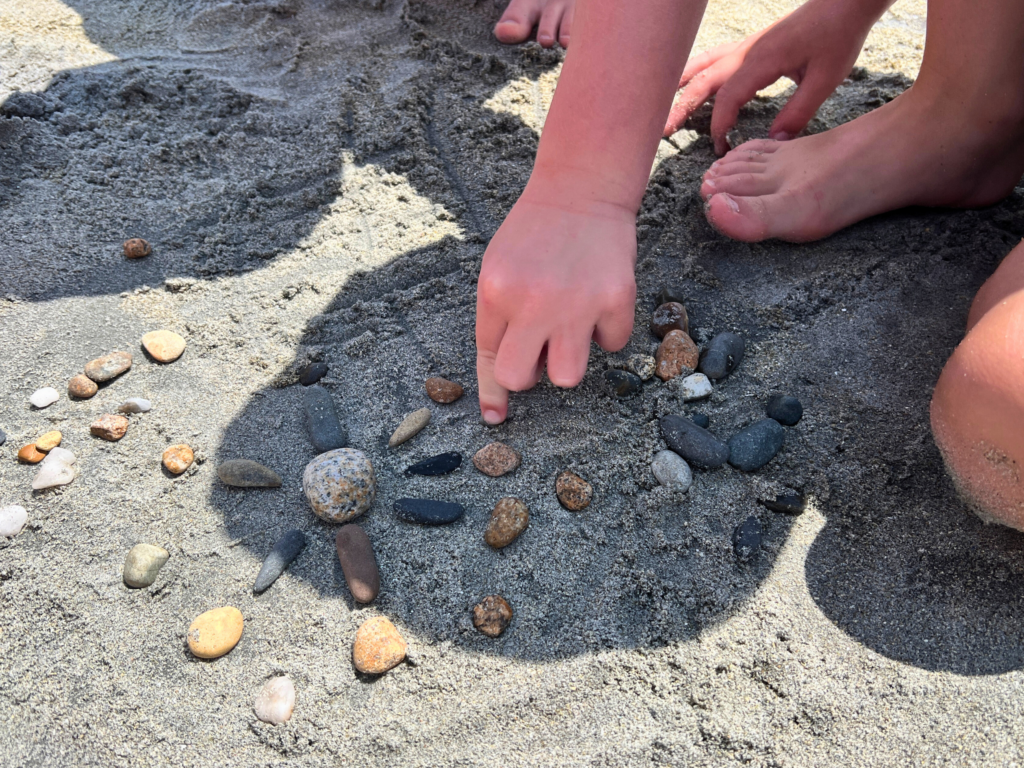
5. Two Dimensional Sandcastles (Drawing with Rocks and Shells)
You can also make large 2-dimensional sandcastles by arranging rocks into walls, doors, windows, and flags. Then add seashell decoration.

Try making a mandala on the beach, with concentric circles of different rocks or seashells you find.
We really enjoy the mandala format and have done a lot with it over the years including flower petal suncatchers, a mandala drawing game, and autumn leaf mandalas.
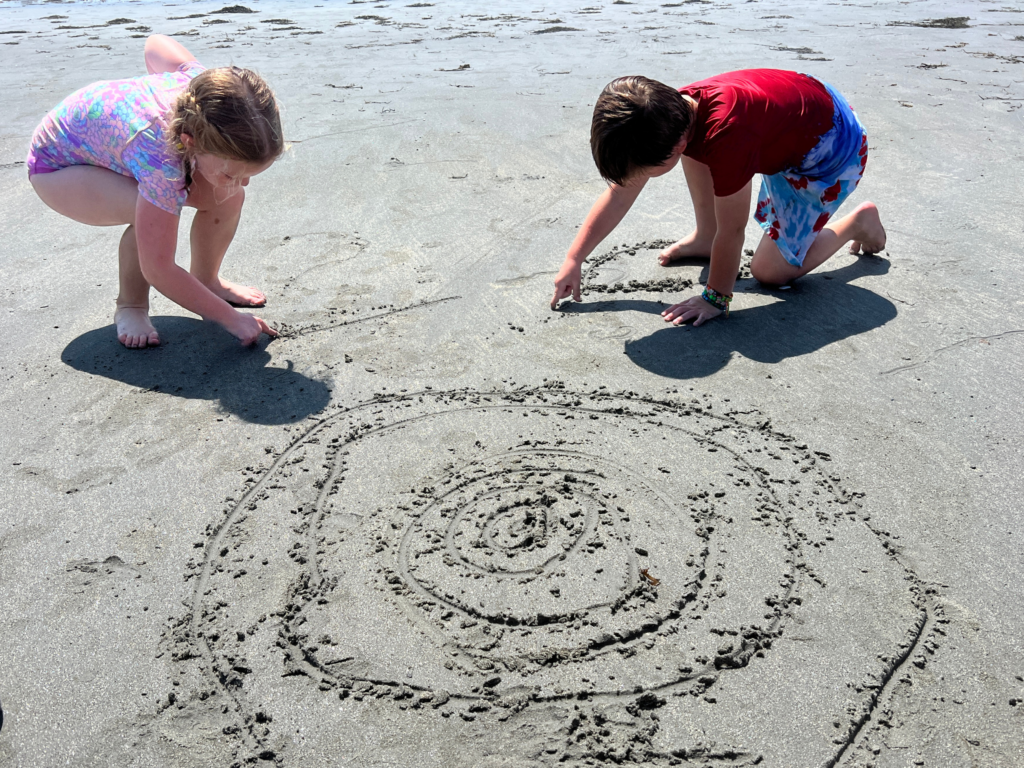
7. Drawing and Writing in the Sand
What is more natural than making marks in the sand? Every kid we know loves to do this at the beach. It can be drawing pictures with their fingers or writing messages and love notes in the sand with feathers and reeds found on the beach.
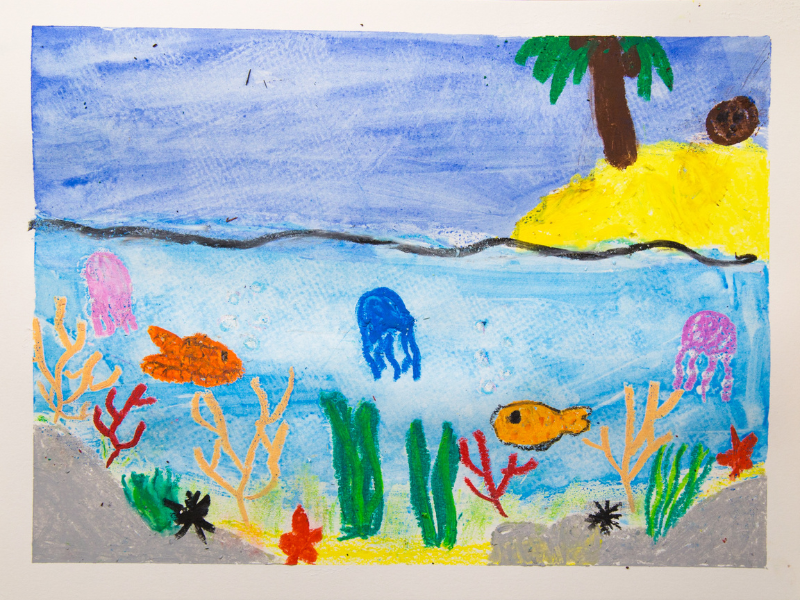
8. Ocean-Inspired Drawing
Let your kids be inspired by the ocean! You can bring a small pad of paper and some drawing materials for when they’re taking a swim break. Maybe they’ll draw what they see on the sand, or maybe they’ll imagine an underwater scene!
9. Sand Casting on the Beach
We love sand casting and have done it on the beach and in the sandbox. It’s a fun process and the finished sand cast makes a great beach memento.
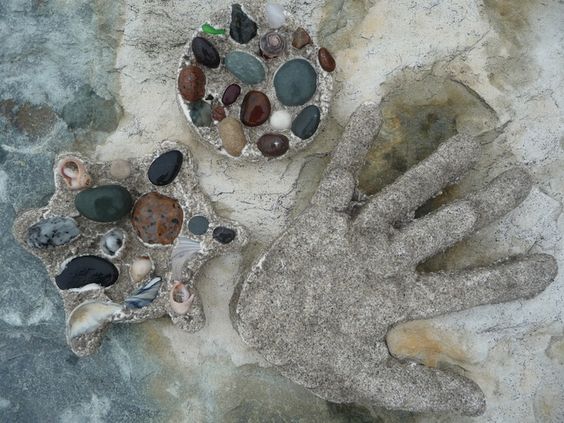
Learn how to do sand casting! This summer project is easy and fun for the whole family!
Have you ever tried casting plaster shapes in sand?
We’ve done sand casting at the beach, digging a hole in the sand, lining it with shells, rocks, and other found treasures, then filling the hole with plaster. It’s fun when you need a break from the water and the result is a pretty awesome memento of your time at the beach.
But if you aren’t able to get to the beach this summer, you can try sand casting in your sandbox.
It works wonderfully! Even better than at the beach, because the conditions are more controlled.
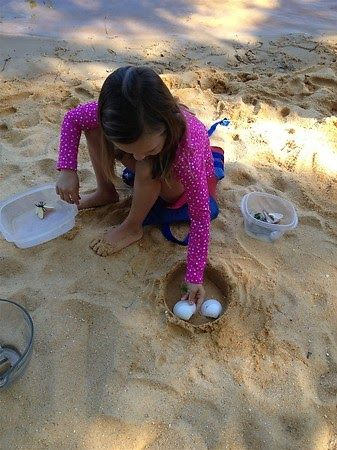
Sand casting
MATERIALS:
Sandbox or beach with sand (or you could do this in a bucket or bin of sand)
Small nature items, such as shells, pebbles, flowers, sticks, etc.
Melted crayon rocks, glitter rocks, or painted rocks (optional)
Small treasures, such as glass beads, marbles, little figurines, etc. (optional)
*Notes about Plaster of Paris:
Be careful not to breathe in the fine, dry plaster dust. We usually measure it out when the kids are in the other room.
Do NOT pour wet plaster down the sink. It will clog your drains. Dispose of any extra plaster in the trash.
INSTRUCTIONS
Dig a hole
First, dig a hole in the sand.
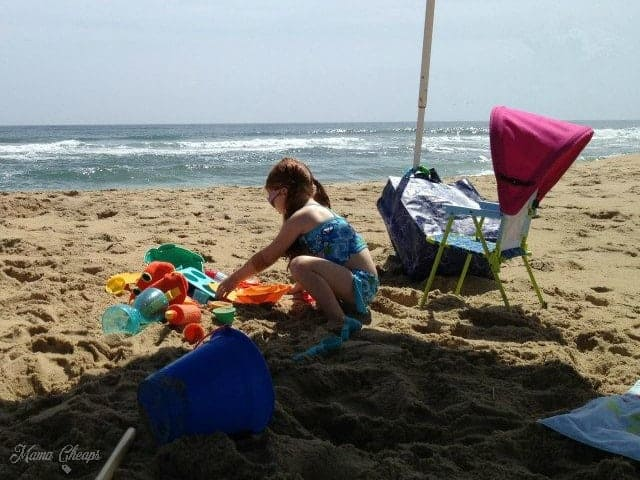
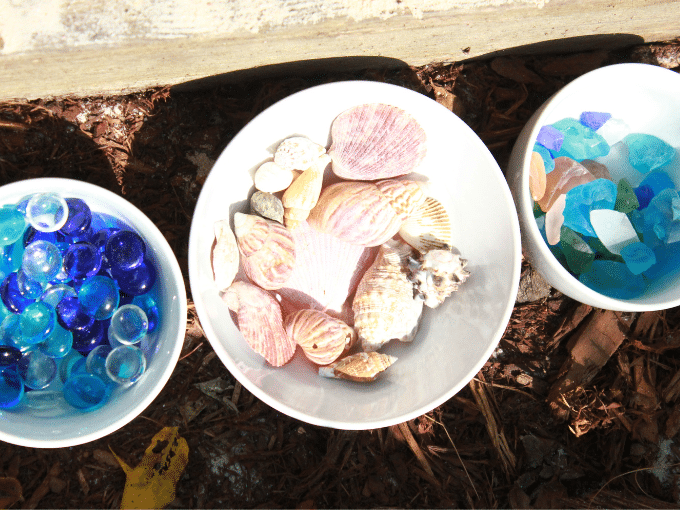
Add treasures
Next, line the holes with your treasures. We like to use shells from past beach trips, beach glass, melted crayon rocks, glass beads, marbles, and flowers.
Mix up plaster of paris
We typically mix up 2 parts dry plaster with 1 part cold water. You’ll want to do it in something you can just throw away afterward (not your best kitchen bowls).
We sometimes measure the plaster and water into gallon ziploc bags and then just use our hands to smush the plaster around until it is mixed. Kids love to do that, too.
Pour the plaster
Pour the plaster into the holes, covering the treasures and filling the holes.
Our kids typically like to decorate the tops, too, so you can poke in another round of flowers, rocks, and treasures.
Let dry
Next you have to wait, as the plaster takes about 30 minutes to set.
Reveal your sand casting!
Once the plaster has set, lift it carefully out of the sand, turn it over, and carefully dust off the extra sand.
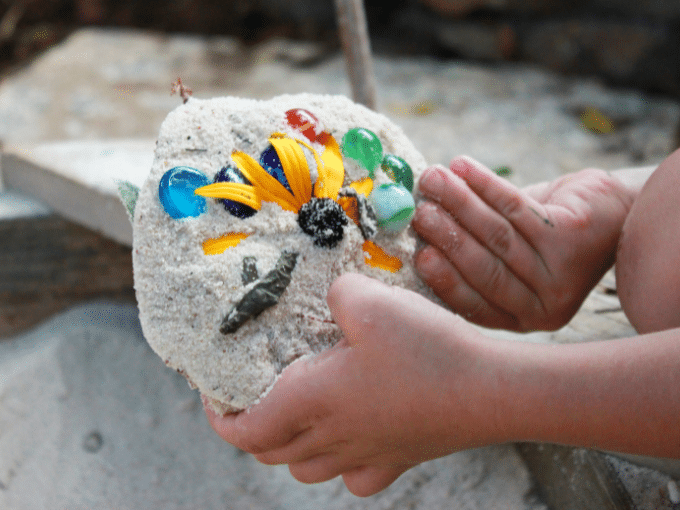

Place your sand casts in a protected place overnight to continue the drying process.
Admire! We especially love the combination of the seashells, glass beads, and melted crayon rocks. You can display your lovely sand casting on a summer nature table, the mantle, or as part of a tablescape.
10. How to Dye Beach Sand
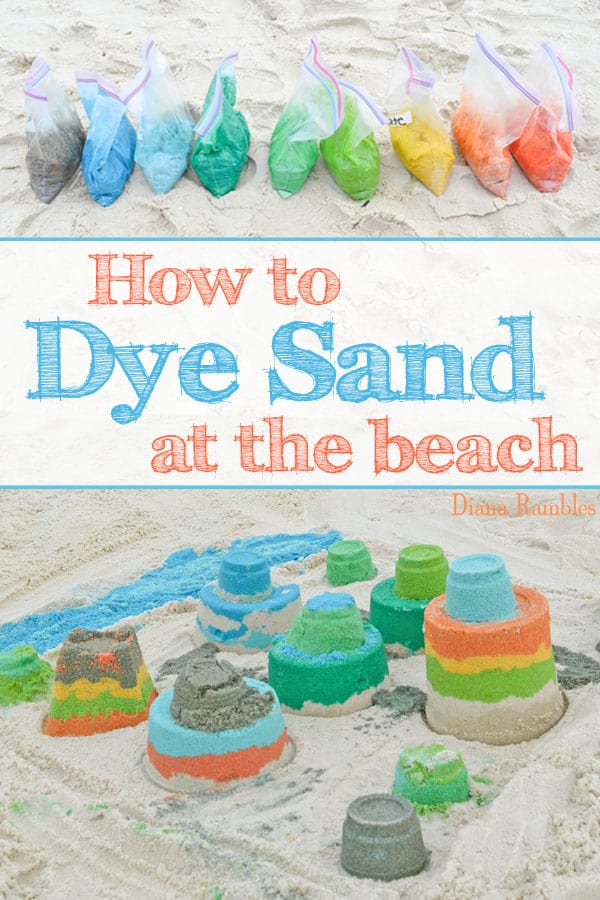
Dye sand to create colorful sandcastles on your next trip to the beach.
Materials
Natural Food Coloring
Quart or Gallon Zipper Bags
Tools
Shovel
Sand Toys
Instructions
Place sand into a plastic bag that zips up.
Add your food dye. Start with about 5-10 drops.
Zip up the bag.
Shake up the bag. Squeeze areas that are concentrated with color.
Add more food coloring and shake until you have desired color.
Create Sand Art Bottles at the Beach
Enjoy making colorful sandcastles or make layered sand art bottles.
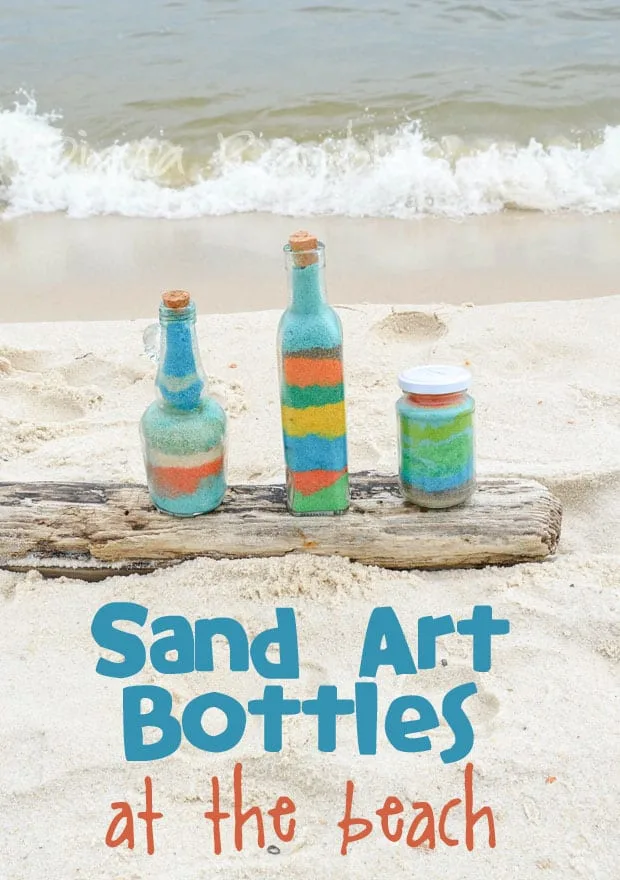
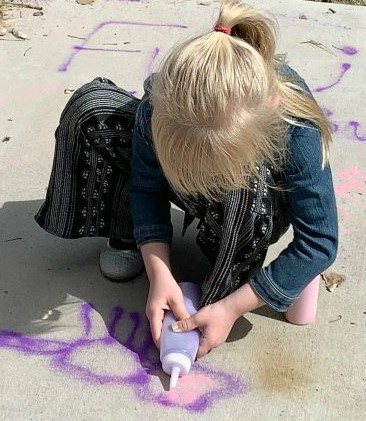

Ideas for CReative play
What are your favorite ocean crafts for kids? Any other ideas to add creativity to a family beach vacations?
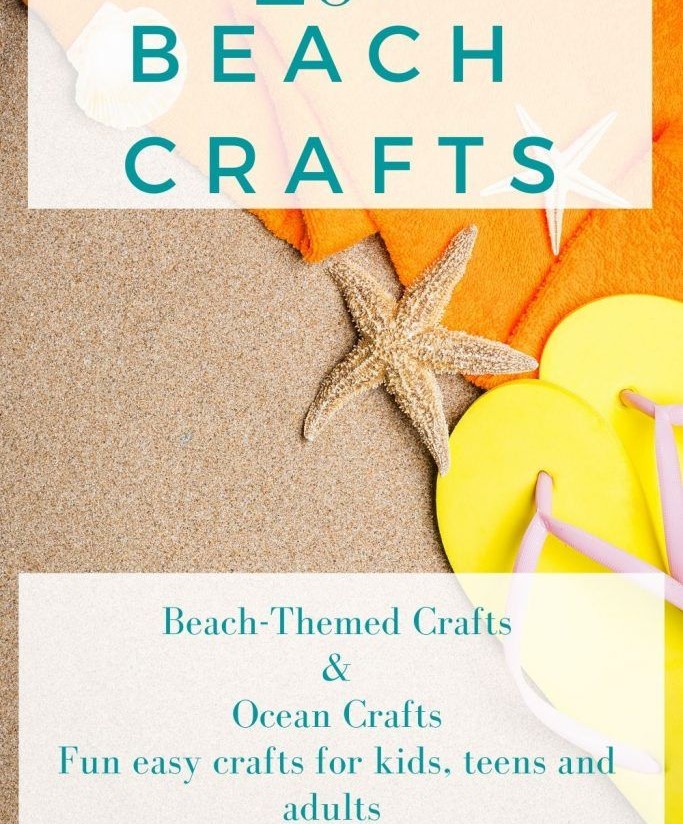
Try Seaweed Weaving
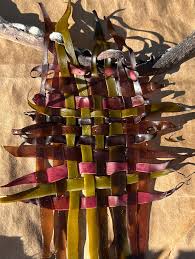
Today we have a fun nature mobile beach craft for kids that doubles as a great way to get your family active. Grab your beach shoes and get ready to forage through the beach to get the supplies for this easy craft! Soak up the last of the warm remnants of summer and spend some time outdoors before the icy temps hit. While you’re out there, keep an eye out for some great supplies in nature for this craft!
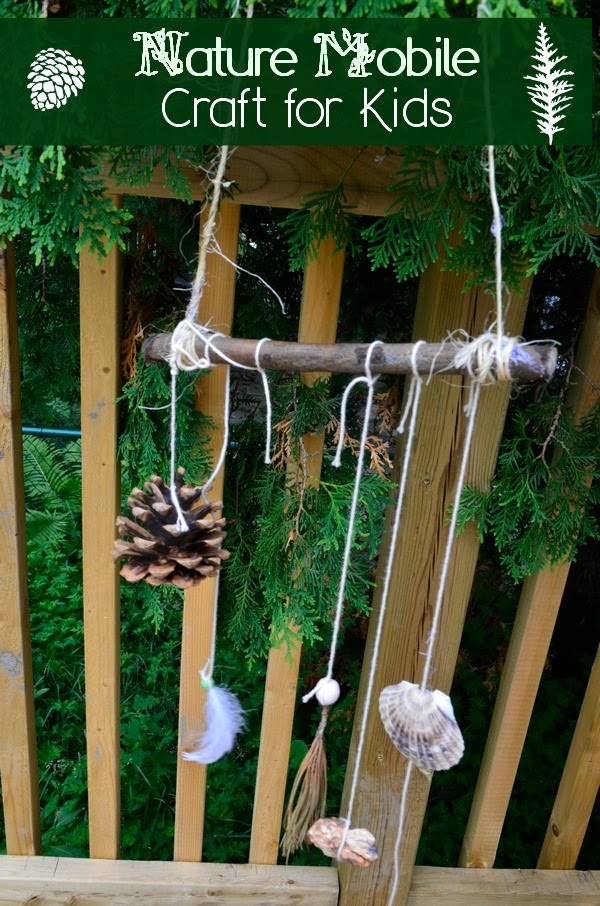
WHAT YOU’LL NEED:
Pinecones, seashells, feathers, cool rocks and any other natural elements that you find on your journey.
Twine or other natural-looking rope
Beads, if desired, preferably in browns, greens and other forest colors.
A thick stick or twig
You can find most of the supplies at a craft store.
HOW TO MAKE IT:
Start by gathering your supplies for this fall craft for kids. This is the really fun part! If you live in a woodsy area, you could find everything you need in your own front yard. For the seashells, dig into your family memory box from past trips to the shore. Don’t have seashells? No big deal, you can really use any natural elements here. The key is to make it meaningful to your family.
Lay everything out in front of you so you can see what you have. Take the thick twig and place it at the top of your surface. Arrange your other elements until you have everything where you want it.
Cut your twine in varying lengths, enough pieces for each item.
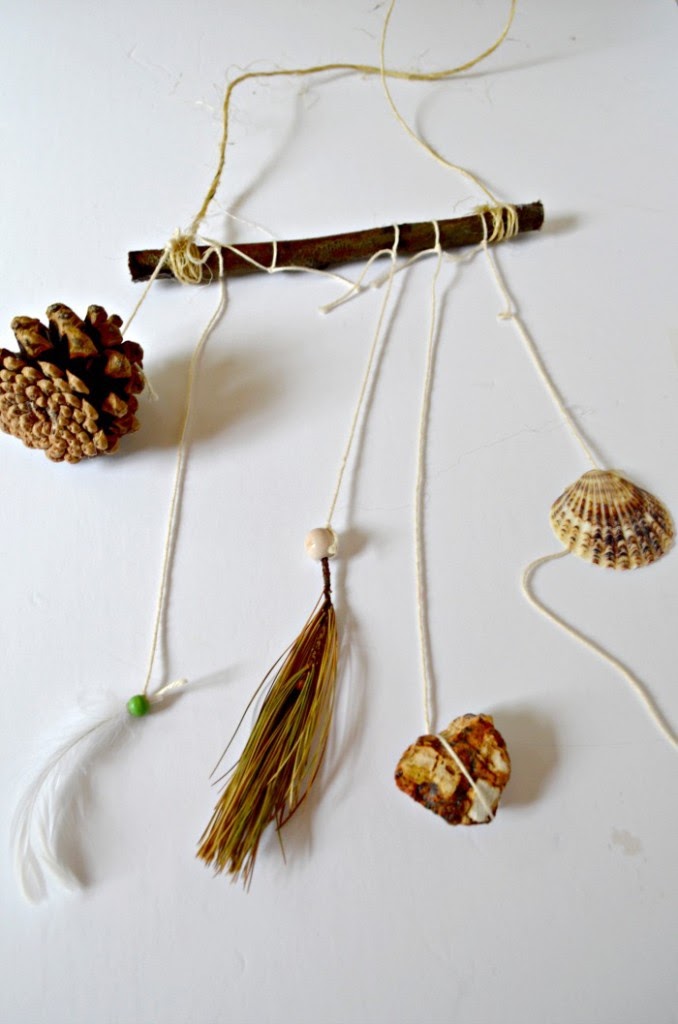
4. Use the twine- and beads, if desired- to attach each piece to the thick stick.
5. Create a hanger by tying the twine to each ends of the stick, with enough give in the middle to let it dangle from your hook.
6. Hang your nature mobile someplace where everyone can admire it!
That’s it! Easy, right? You could take this nature mobile fall craft for kids in so many different directions. Make one each season and bring it out to celebrate the change in weather. Make it a new tradition: when you go on vacation, search for items for another mobile. The great thing about this fall craft for kids is that it has the potential to bring the entire family together.
DIY Pressed Nature Suncatcher Craft for Kids
This activity was inspired by our DIY Nature Slides for the light table. It uses simple materials and not only teaches kids about the environment in their area but it’s also a fun activity to work on fine motor skills.
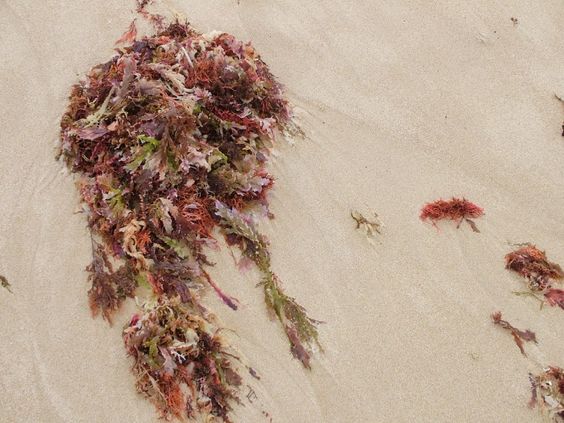
Materials:
Seaweed from the shore
Laminator
Laminating pouches
String
Scissors
Hole punch
Tape or suction cups
Start this activity outside by collecting seaweed from a beach. My daughter calls this part a “nature adventure” as we take magnifying glasses and bag for our finds with us and walk around the neighborhood. It’s a great way to begin discussions about local plant life and the life cycle of plants.
Once we collected a few different types of seaweed we took them home and laminated them for visual inspection and learning.
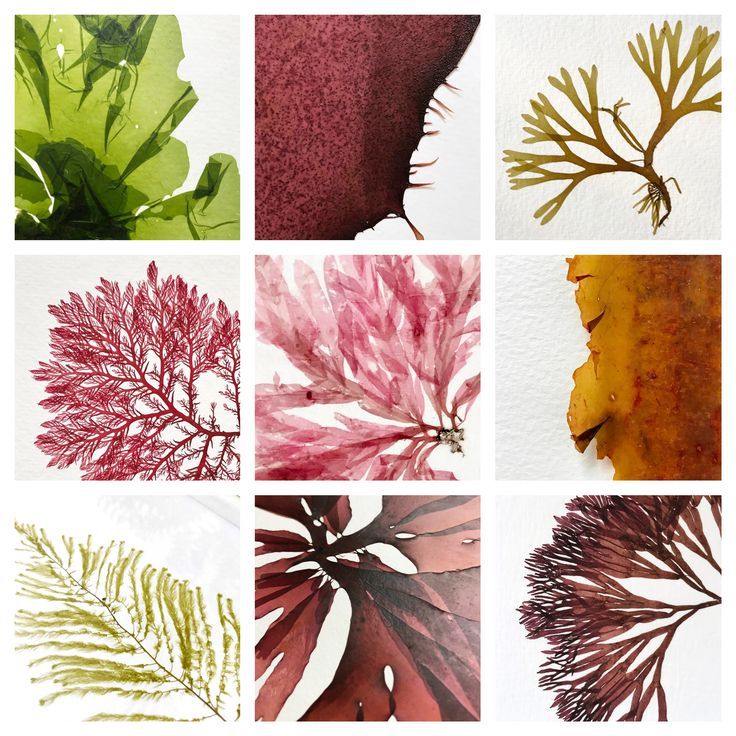
For this activity, we just laid the seaweed on the laminating pouches and ra, cut off the excess stems, and sent them through the laminator. If you have more time I’d recommend pressing the seaweed first but my daughter didn’t want to wait a week or two to see her nature suncatchers so we just did them as is.
Wax Paper Pressing Method
One of the most common ways to preserve botanicals is by pressing them between wax paper. To press seaweed using wax paper, first rinse the seaweed and arrange it on a sheet of heavy paper or cardstock in a shallow tray of water. Carefully lift the paper with the seaweed from the water, letting excess water drain, then cover the specimen with a sheet of wax paper to prevent sticking. Place this "sandwich" between layers of newspaper and cardboard, stack several specimens, and apply heavy weight on top with books or a plant press to dry them out, replacing the damp paper daily until dry.
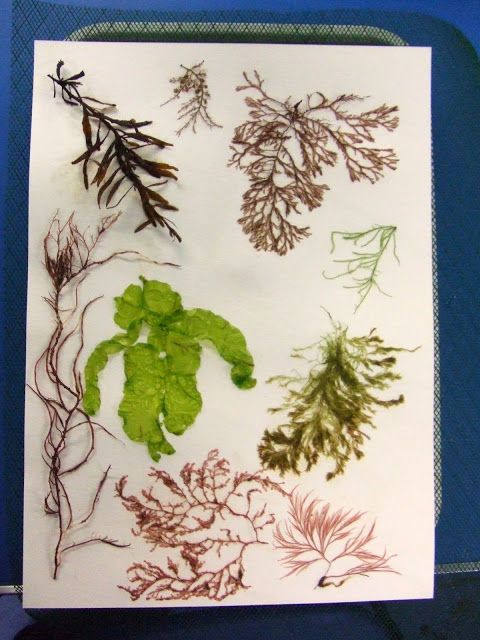
What You Need:
Leaves or seaweed
Wax paper
Thin towel or paper
Iron
Ironing board
What You Do:
Place some leaves or flowers or between two pieces of wax paper.
Put a towel or a piece of thick paper over the wax paper.
Press on the towel or paper with a warm iron to seal the wax sheets together. This takes about 2-5 minutes on each side, depending on how moist the leaf is. Once you have finished one side, flip the leaf over and do the other side.
Cut around the leaf, leaving a small margin of wax paper to ensure that it will stay sealed.
Rather than cutting out the leaves, you may want to try to peel the wax paper off the leaves, leaving a coat of wax behind to protect the leaves. Try this on one leaf first to see if this method works for you.

Bringing Nature Home!
Check out these fun-filled ideas that will help you enjoy the great outdoors with hands on nature activities. Choose a few and head outside, what are you waiting for?

Make a seaweed forest Collage
Press your seaweed as you would a flower (for 2+ weeks) but if it's a delicate feathery one, pop a sheet of paper in an oven tray and then add 3-4mm of water. Pop the seaweed in and let it spread out before gently tilting the tray so the water drains. Press the wet paper between two sheets of chunky cardboard and put a heavy weight on top. See if you can name the seaweed you find using this guide. Frame the picture to keep the out-of-sight ocean plants in mind when thinking about the importance of protecting our oceans.
Seashell Wind Chime

Create a captivating seashell wind chime that will not only enhance your outdoor space but also bring the soothing sounds of the ocean to your home.
Start by selecting a variety of seashells, each with its unique shapes and sizes, to create a visually stunning piece.
Use sturdy fishing line or string to suspend the shells from a wooden or metal frame that you’ve assembled.
Hang the wind chime in an area where it can catch the breeze and produce a delightful melody.
Each gentle sound will transport you to a serene beach, making your outdoor escape more enchanting.
Seashell Picture Frames
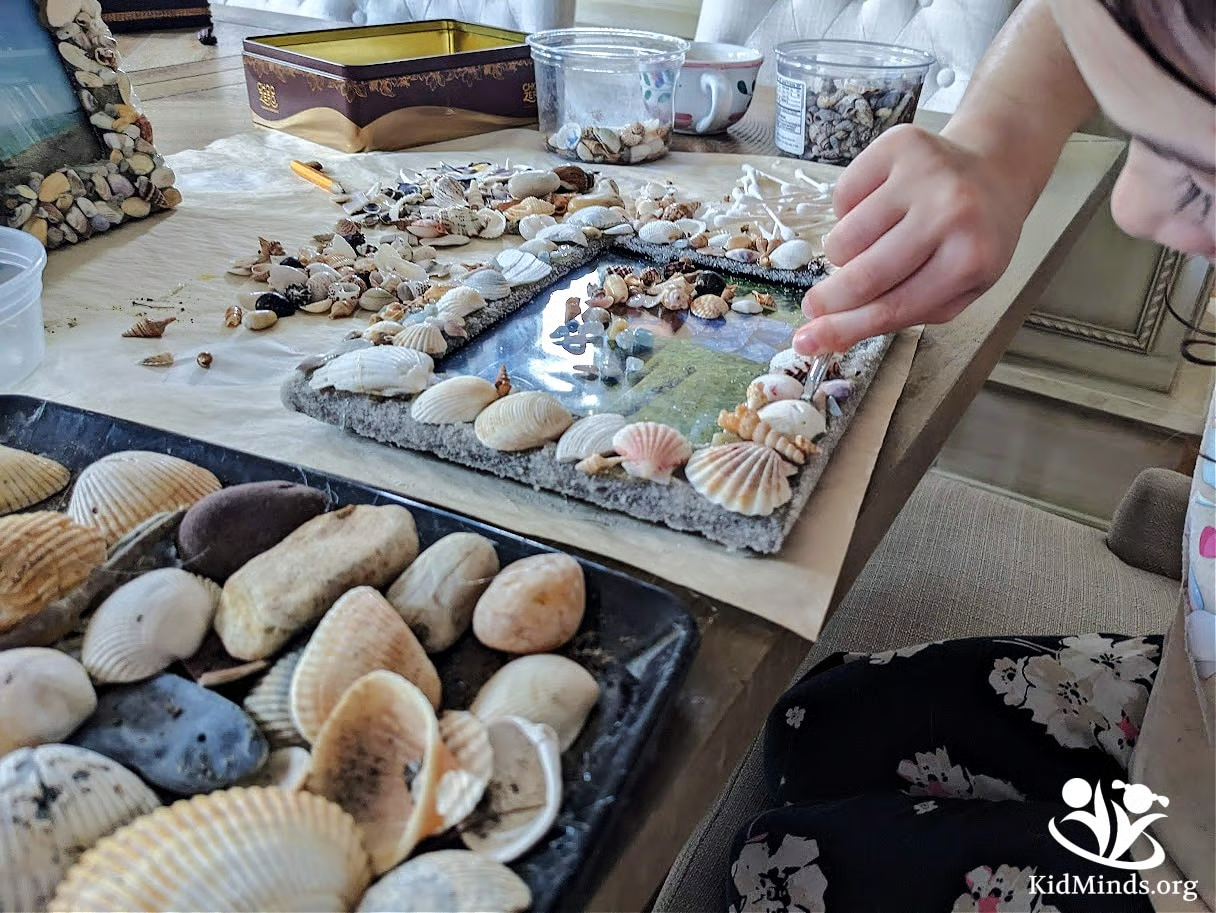
Transform your cherished memories into exquisite beach-themed decor with custom seashell picture frames.
Begin with a basic wooden or plastic frame and collect an assortment of seashells in various shapes and sizes, giving you complete creative freedom.
Using a hot glue gun, meticulously attach the shells around the frame’s edges, crafting a stunning border that reflects the beauty of the ocean.
For a cohesive look, you could arrange the shells in a harmonious pattern, or for added character, opt for a more random, eclectic arrangement.
Once the glue sets, place a beloved photo from your beach outings or another special moment within the frame.
Seashell Magnets
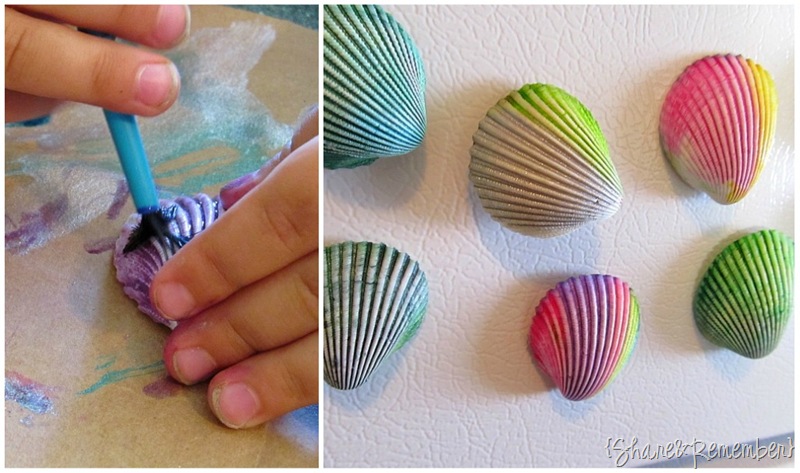
Infuse your kitchen with a taste of the ocean by creating charming seashell magnets that combine functionality with artistry.
Start by sourcing small, lightweight seashells that are easy to work with and visually appealing.
After thoroughly cleaning each shell to ensure a polished look, select a strong adhesive or hot glue to securely attach a small magnet to the back of each.
This step is crucial, as the magnet needs to hold tight against the refrigerator surface.
Allow sufficient drying time for the glue to set before adorning your fridge with these delightful creations.
These seashell magnets not only bring cheerful, beachy vibes to your kitchen but also serve as ideal souvenirs or thoughtful gifts for those who cherish the ocean’s charm.
Seashell Shadow Box

Transform your cherished beach memories into stunning wall art with a seashell memories shadow box.
Select a shadow box frame that suits your décor, and gather an assortment of your favourite seashells.
The arrangement is key; play with different layouts and combinations until you create a visually striking display.
To elevate your piece, consider incorporating other beach-themed elements such as a fine layer of sand, colourful small pebbles, or shimmering sea glass.
Once you’re pleased with the arrangement, secure each item using a strong adhesive, ensuring they stay firmly in place.
Finally, hang your completed shadow box on the wall, and let it evoke the serene beauty of the beach every time you glance at it. You can find lots of fun seaweed activity ideas below to explore and learn more about this amazing algae.
Create a seaweed scrap book
Collecting and drying seaweed to place in scrapbooks was a popular Victorian past time, especially for women who weren’t often allowed to take part in natural science activities. Even Queen Victoria enjoyed creating a seaweed scrap book as a young girl. All you need for this activity is a scrapbook and pliers or a stick to pick up the seaweed with and carefully arrange it on the pages. You can then leave the seaweed to dry as it is or place blotting paper on top and sandwich it between the pages of the book to dry flatter.
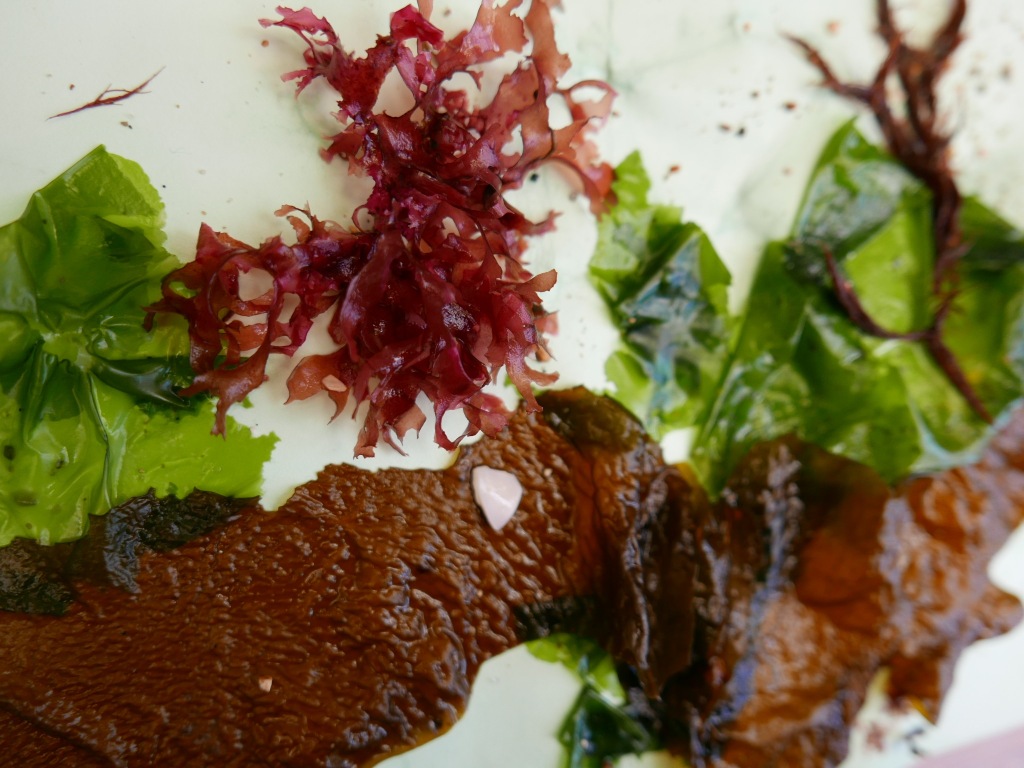
Make a Seaweed suncatcher
We love making suncatchers, they are so pretty and effective. To make a suncatcher you will need some clear wax paper or clear contact paper. We hate to waste anything and recycling and reusing materials is one of many small things we can all do to help the environment. So instead of chucking used packaging we like to find ways to use them in crafts and activities.

Paint a thin layer of pva glue over the sheet of plastic and then arrange the seaweed on top in any shape, pattern or position you like. When you have finished arranging the seaweed simply leave it to dry. Hold it up to the light or a window and voila your sun catcher is finished, it really is that simple. You can also add ribbon, wool or string to them to turn them into hanging decorations to place in windows, walls or hang them from trees.
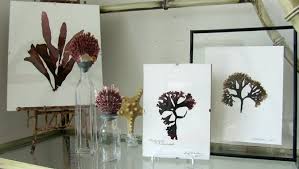
Make a seaweed nature collage
Making nature collages is a fun activity for children of all ages and abilities. It encourages creativity and helps develop fine motor skills. All you need is some paper or recycled cardboard, Firstly you need to draw or paint simple pictures or marine animals onto the paper or cardboard like fish. Next collect some seaweed and arrange it over the picture to create a seascape or scene.
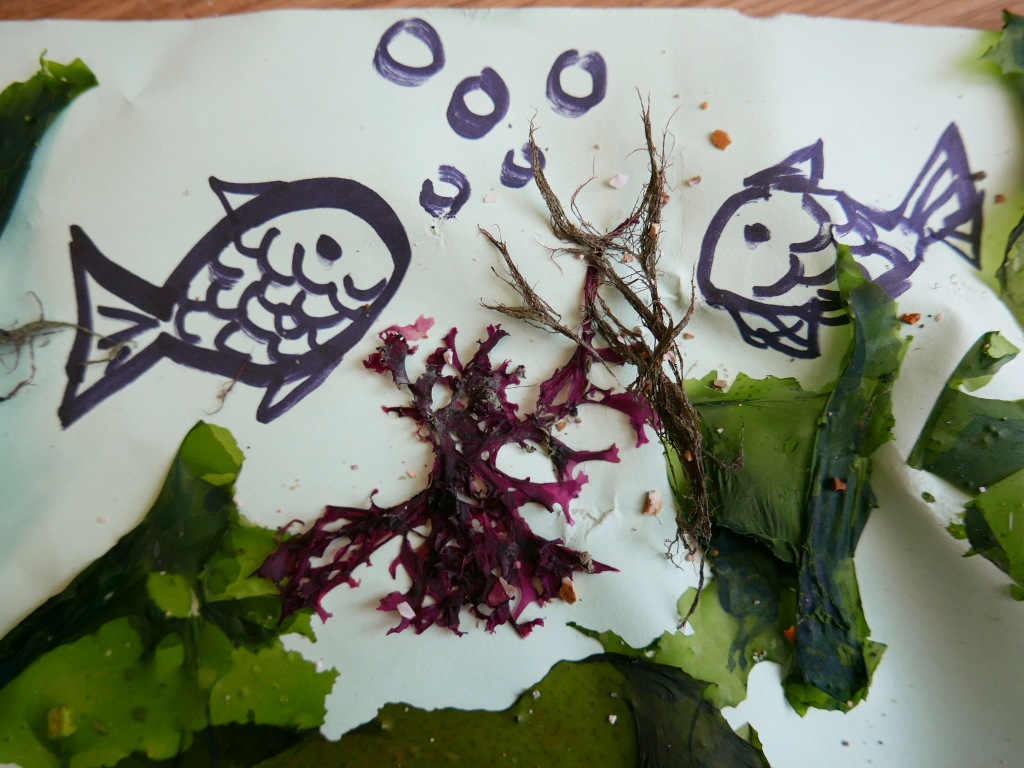
Make a seaweed vase or lantern
To make a seaweed lantern all you need is a glass jar, pva glue and some seaweed. Simply paint a thin layer of pva glue over the outside of the jar and then arrange the seaweed on top in any shape, pattern or position you like. When you have finished arranging the seaweed simply leave it to dry.
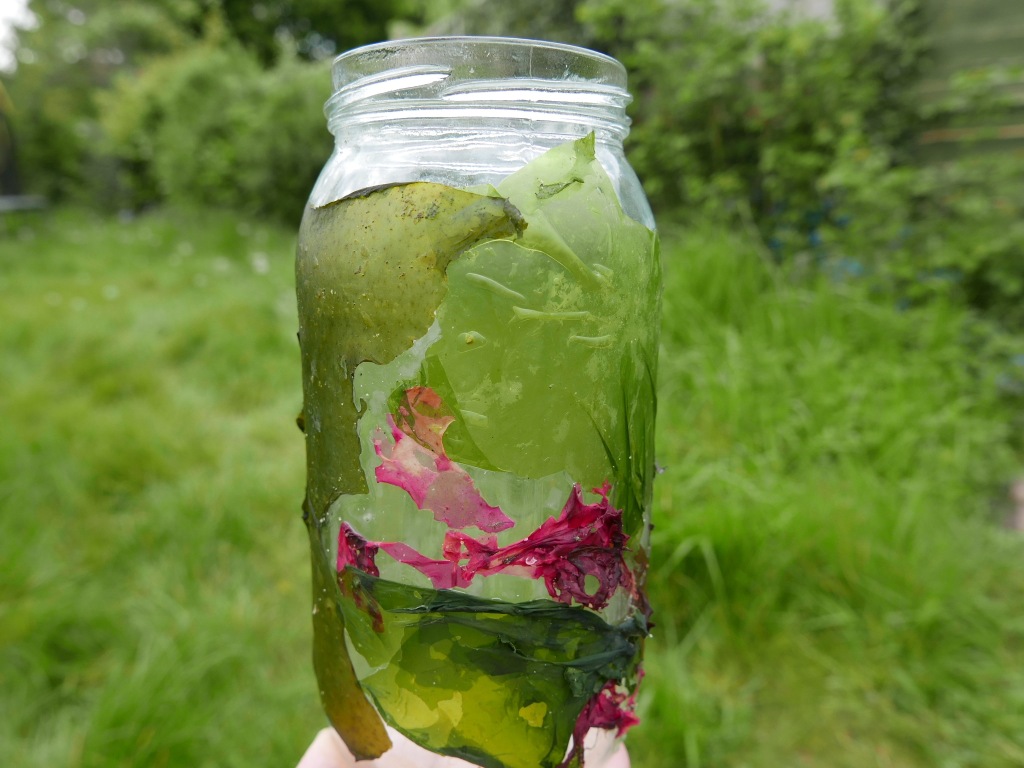
When the glue has dried you should have a beautiful stained glass effect. You can then either use the jar as vase for flowers or a pencil pot . Or you can place a tealight candle in it, to turn it into a beautiful lantern. Be careful to supervise children as the glass can get hot and never leave the lantern unattended as its a potential fire hazard.
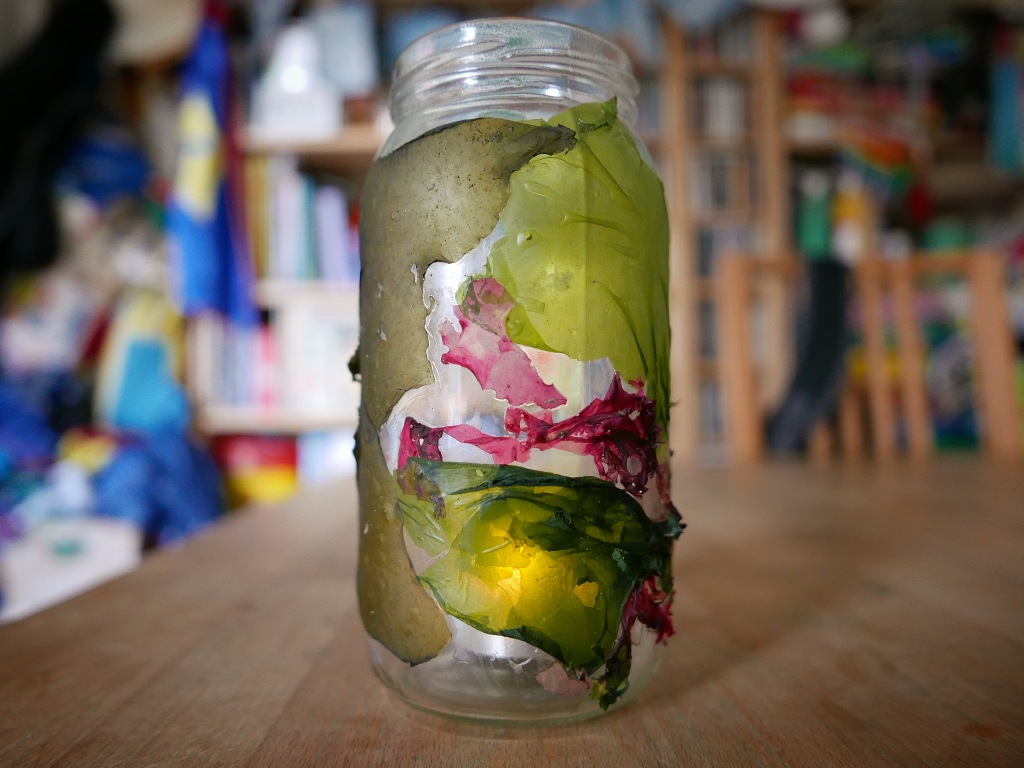
Beach Sports
Your Guide to Beach Sports Fun
- on the sand and in the surf
Sun's out, fun's out (and maybe a few tumbles)
Feeling the ocean's call but yearning for more than just sunbathing? Discover the athletic world of beach sports! From conquering waves to mastering sandy sprints, discover the joy (and occasional comical chaos) of seaside activities.
Well, folks, we've navigated the sandy battlefields and the salty shenanigans of the beach sports universe.
So, before you head out to conquer those sandy or watery arenas, a few pearls of wisdom:
Hydrate like a marathon runner: The sun is sneaky, and so is the exertion involved in looking like you're having effortless fun.
Sunscreen is your best friend: Unless your goal is to resemble a cooked lobster, slather it on liberally.
Embrace the wipeout: Seriously, some of the best laughs come from spectacular fails. Just make sure someone has a camera ready (for posterity, of course).
Bring snacks: All that battling the elements (or a slightly deflated beach ball) works up an appetite.
A good pair of sunglasses is essential: Not just for looking cool, but for shielding your eyes from both the sun and the blinding spray of a rogue wave (or a particularly enthusiastic frisbee throw).
Now get out there, have some fun, and try not to let a friendly game of beach paddle turn into a full-scale paddle-wielding duel. Happy beach sporting!
Beach sports on the sand

This category of beach sports includes all the organized sports of the world that are played on the beach, or at least on a sandy surface, plus others nearby in the surf. Some are just traditional field sports that have been adapted to be played on the sand surface of the beach, while others have developed independently as suited for the beach environment.
Next, step right up, sandy athletes and sun-kissed goofballs. Prepare for a chuckle-filled journey into the realm of beach sports where the playing field constantly shifts, and the footwear is strictly optional (unless you count a rogue flip-flop). So, dust off your sense of humor and maybe bring a towel – things are about to get gritty.
Beach Volleyball
The sport where bronzed gods and goddesses (and the occasional well-meaning but slightly sunburnt mortal) leap and dive with the grace of seagulls who just spotted unattended food. Picture a sandy arena where the primary uniform seems to be questionable tan lines and sunglasses perched precariously on sweaty foreheads. The objective? To strategically whack an inflatable sphere over a net, often accompanied by dramatic dives that result in more sand in unmentionable places than a toddler at playtime.
While volleyball is a high-energy indoor dance with six players on a hard court, beach volleyball is a smaller, sandier, barefoot ballet with any number of players battling elements (and occasional rogue seagulls). And don't let all that playful banter and strategic deployment of questionable 'power serves' fool you. Those gravity-defying jumps? Excellent for leg power and cardiovascular fitness. The frantic scurrying across the sand? A fantastic way to improve agility and burn off those extra vacation tacos. And let's not forget the arm movements – all that spiking and setting builds impressive shoulder and arm strength.
Best for: leg power, cardiovascular fitness, agility, shoulder and arm strength
Beach Soccer/Football
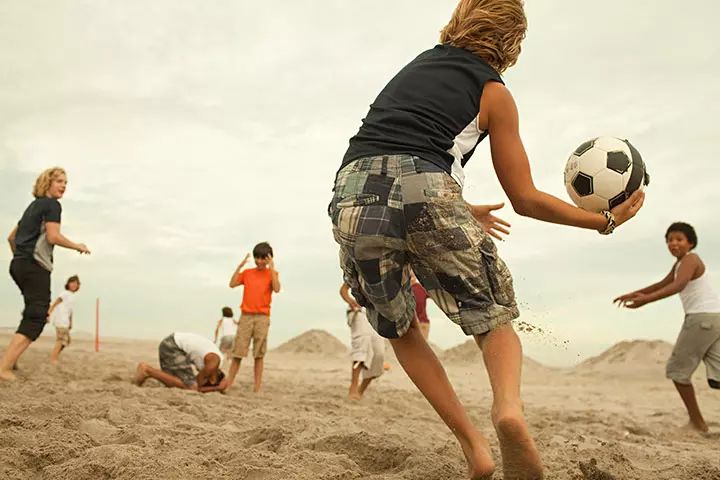
The beautiful game, reimagined with sand in places where sand should absolutely not be. Picture two teams of barefoot athletes gallantly chasing the usual ball, but across the unpredictable beach terrain. Dramatic dives are less about tactical advantage and more about the sudden realization that sand is a softer landing pad than the pitch. Just try not to mistake a stray crab for a particularly aggressive defender.
Soccer involves precisely kicking a ball on a green field with appropriate footwear, while beach soccer is a barefoot, sandy sprint where every touch feels like a mini-adventure (and a mouthful of grit). And remember that running on sand, whether wet or dry, engages leg muscles far more intensely than a manic sprint on solid ground. The constant need for balance and quick changes in direction builds incredible agility and core strength. And those spectacular overhead kicks? Fantastic for flexibility and coordination, even if they occasionally result in a mouthful of granules.
Best for: leg muscles, building agility and core strength, and improving flexibility and coordination.
Ultimate Frisbee
The sport where athleticism meets the graceful aerodynamics of a plastic disc, often resulting in scenes that resemble a flock of particularly enthusiastic (and occasionally clumsy) seagulls chasing after a lost French fry. Picture barefoot individuals sprinting across the sand, occasionally launching themselves into dramatic, sandy layouts that would make a professional volleyball player raise an eyebrow (and possibly offer a towel).
But beneath all this childlike delight lies a workout that’s the equivalent of your parents hiding healthy veggies in your favorite meals. All that running on the soft sand? A fantastic way to build lower body strength and cardiovascular endurance, leaving one feeling gloriously winded. The throwing motions? Engage the shoulders, arms, and core in a dynamic way. And the constant jumping and diving? Excellent for agility and coordination, even if it sometimes results in a mouthful of fine silica.
Best for: lower body strength, cardiovascular endurance, shoulder, arm, and core engagement, plus agility and coordination.
Beach Yoga
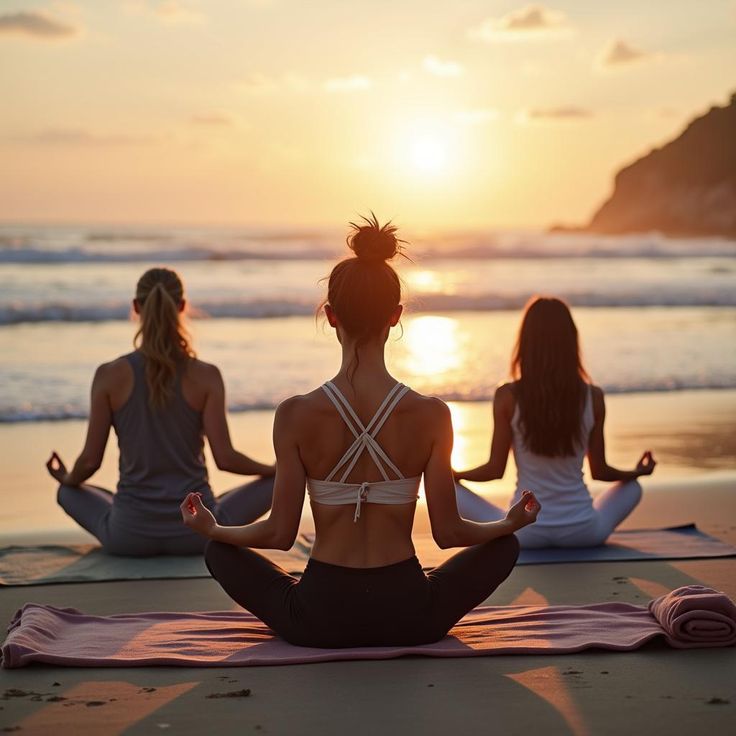
The serene spectacle of individuals contorting themselves into various poses on a sandy canvas, often while battling rogue gusts of wind that threaten to tip them over. Picture a tableau of zen-like concentration, occasionally interrupted by a startled yelp as a curious crab attempts to join a meditative plank. Participants often sport an air of profound tranquility, which may or may not be entirely genuine when a particularly persistent grain of sand finds its way into an inconvenient crevice.
The yoga that you do as a disciplined practice on a calm studio mat is pretty different from doing it on the beach yoga where you could occasionally share your downward dog with a curious canine. Plus, balancing on uneven sand engages core muscles and improves stability in ways a studio floor can only dream of. Holding poses against the gentle sway of the ocean breeze enhances strength and endurance. And the mindful movements, while occasionally resembling a confused starfish, improve flexibility and range of motion.
Best for: core muscles, improved stability, strength, endurance, flexibility, and range of motion.
Beach Team Sports
Beach Basketball — a version of basketball played on sand with two teams of three players.
Beach Handball — a variation of Team Handball, played on sand instead of indoors. This sport is sometimes called Sandball.
Beach Netball — netball played in the sand on a half court.
Beach Rugby — a version of rugby played on the sand.
Beach Soccer — similar to association football but played on a beach or sand.
Beach Ultimate — a version of ultimate frisbee played at the beach
Beach Cricket — a casual, informal version of cricket played on beaches with simplified rules and equipment.

Beach Net Sports
Beach Tennis — a sport which has elements from tennis and volleyball, and played on the beach.
Matkot — a beach paddle sport from Israel that is very similar to beach tennis.
Beach Volleyball— A version of Volleyball played on and with teams of two players, in which a ball is hit by hand over a high net, the aim being to score points by making the ball reach the ground on the opponent's side of the court.
Footvolley — like beach volleyball though you can only use your feet.
Other Beach Sports
Beach Golf — a simplified version of golf played on sand with a polyurethane foam ball.
Beach Woodball — a version of Woodball played on sand that involves using a mallet to pass a ball through gates.
Beach Wrestling — a standing up position style of wrestling conducted on beach sand.
Beach Sambo — a modified version of sambo played on the sand, with bouts lasting three minutes, without penalties and mat wrestling.
Sandboarding — involves sliding on the sand while standing on a board.
Matkot / Frescobol — a beach paddle sport similar to beach tennis, played in Israel and Brazil.
Beach sports in the SURF or sea

Water babies and wave warriors, let's first dive headfirst into the wacky world of beach sports that dare to tango with the tide. Grab your swimsuit and your sense of humor, because things are about to get a little salty... and possibly involve someone looking like a bewildered seal.
Surfing
Let's start with the classic beach sport. Surfing: the art of looking effortlessly cool while battling the relentless ocean on (what is essentially) a slippery plank. Imagine a figure, silhouetted against the setting sun, poised majestically atop a wave… for approximately three seconds before being unceremoniously swallowed by the foamy abyss.
This individual, often clad in body-clinging wetsuits and sporting hair bleached by the sun (or a bottle, no judgment), is engaged in a timeless dance with nature, mostly involving a lot of paddling and the occasional wipeout that resembles a washing machine on spin cycle.
But beneath the 'hang loose' hand gestures and the pursuit of the 'gnarley' wave lies a demanding physical activity. All that paddling? It's a fantastic upper body workout, building strong shoulders and back muscles. The constant balancing act? Engages the core like a Pilates instructor on overdrive. And the explosive bursts of energy needed to catch a wave? Excellent for leg strength and cardiovascular fitness.
Best for: strong shoulders, back, core, legs and cardiovascular fitness.
Bodysurfing
The purest, most primal form of wave riding, bodysurfing is often practiced by individuals who don't have a surfboard (or left theirs at home). Picture a human torpedo launching themself headfirst into an oncoming wave, propelled by nothing more than sheer audacity and perhaps a pair of stylish hand planes (mini surfboards for the hands) that make them look like aquatic superheroes who've lost their capes. These brave souls engage in a watery ballet, sometimes graceful, often resembling a frantic attempt to outswim nature.
However, don't let the seemingly minimalist approach fool you. Bodysurfing is quite an effective way to get in shape. The powerful kicks needed to catch a wave? Fantastic for leg and glute strength. The streamlined body position and arm movements? Engage the core and upper body in an intense way. And the sheer act of battling the relentless energy of the ocean? A cardiovascular workout that will leave one feeling gloriously exhausted.
Best for: strong legs, glutes, core, upper body and cardiovascular fitness.
Stand-Up Paddleboarding
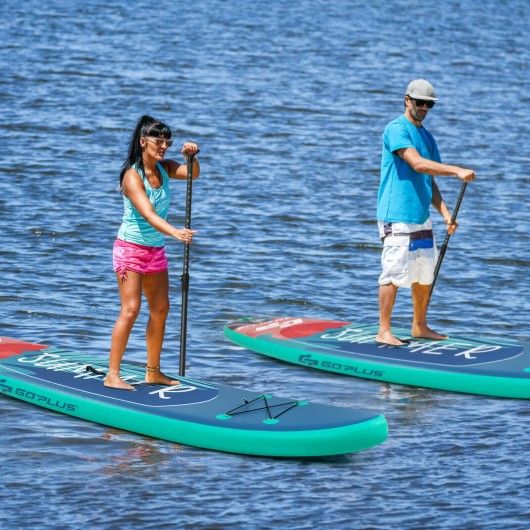
Ah, SUP as the cool kids call it (usually with their SUP pups perched on the front of their boards). You've seen these folks at calmer beaches: an individual bravely balancing on what is essentially an oversized surfboard, looking for all the world like a dignified pelican. This majestic being then proceeds to propel themselves across the water with a single, elegant oar, often while sporting an expression that screams, "I'm on vacation and I will achieve peak relaxation."
The veneer of leisurely paddling and the occasional dramatic tumble into the potentially chilly ocean is actually a front for a challenging workout. That gentle-looking stroke? Engages the core like a plank on steroids. Those subtle adjustments for balance? Leg muscles are screaming in silent protest. And navigating those gentle waves? Well, just try and maintain your stability while keeping an eye on the shore (without getting into an argument like my friends).
Best for: strong core, legs, and improved balance.
Sea Kayaking
One could say that this is the leisurely pursuit of individuals who enjoy looking like brightly colored, slightly damp bananas bobbing serenely on the vast ocean. Picture a sleek vessel, piloted by someone who looks like they own at least three different types of waterproof hats. This intrepid explorer then proceeds to gently paddle across calm stretches of sea, occasionally pausing to admire the view of the holiday destination from a whole other angle.
Don’t think the tranquil facade of gliding across the waves contains a robust workout? That rhythmic paddling motion? A fantastic way to build upper body strength, particularly in the back, shoulders, and arms. The constant need for balance as the kayak gently rocks? Engages the core muscles in a subtle but effective manner. And those longer excursions exploring the coastline? A wonderful way to improve cardiovascular endurance, all while pretending to be a modern-day explorer (minus the scurvy and the constant fear of falling off the edge of the world).
Best for: strong upper body, core muscles, and improved cardiovascular endurance.
Windsurfing
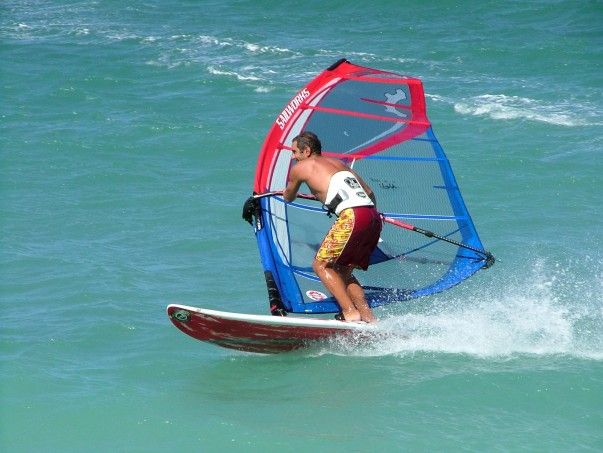
Think sail + surfboard and picture a determined figure, clinging valiantly to a boom, looking for all the world like they're trying to wrestle a very stubborn, oversized butterfly net. This dedicated windsurfer then attempts to harness the power of the wind, resulting in a series of graceful glides interspersed with moments of looking like they're auditioning for a slapstick comedy routine involving a lot of splashing.
Those sometimes-awkward maneuvers will give you an incredible workout. Constantly adjusting the sail to catch the wind? It’s a fantastic upper body and core workout, engaging muscles you didn't even know existed. Maintaining balance on the board while being propelled by the elements? Excellent for leg strength and stability. And the sheer determination required to stay upright and navigate the waves? A solid cardiovascular challenge.
Best for: strong upper body, core, legs, improved balance and cardiovascular fitness.
Kitesurfing
The extreme sport for those who thought windsurfing was just a tad too…grounded. Picture a daredevil harnessed to what appears to be an oversized, brightly colored kite, looking either fearless or like a startled Mary Poppins caught in a hurricane. This brave soul then proceeds to launch themselves across the water, occasionally achieving impressive altitudes that make nearby seagulls eye them with a mixture of envy and concern. Wipeouts often involve dramatic splashes and the kite doing its best impression of a rogue inflatable bouncy castle.
But beneath the adrenaline-fueled acrobatics lies a demanding physical activity. Wrangling that powerful kite? It's a full-body workout, engaging the core, arms, and back in a constant tug-of-war with the wind. The balancing act on the board while being propelled by a giant sail? Excellent for leg strength and stability. And the sheer effort of staying upright and maneuvering through the waves? Again, a fantastic cardiovascular challenge.
Best for: strong core, arms, back, legs, and cardiovascular fitness through balance and maneuvering.
Skimboarding
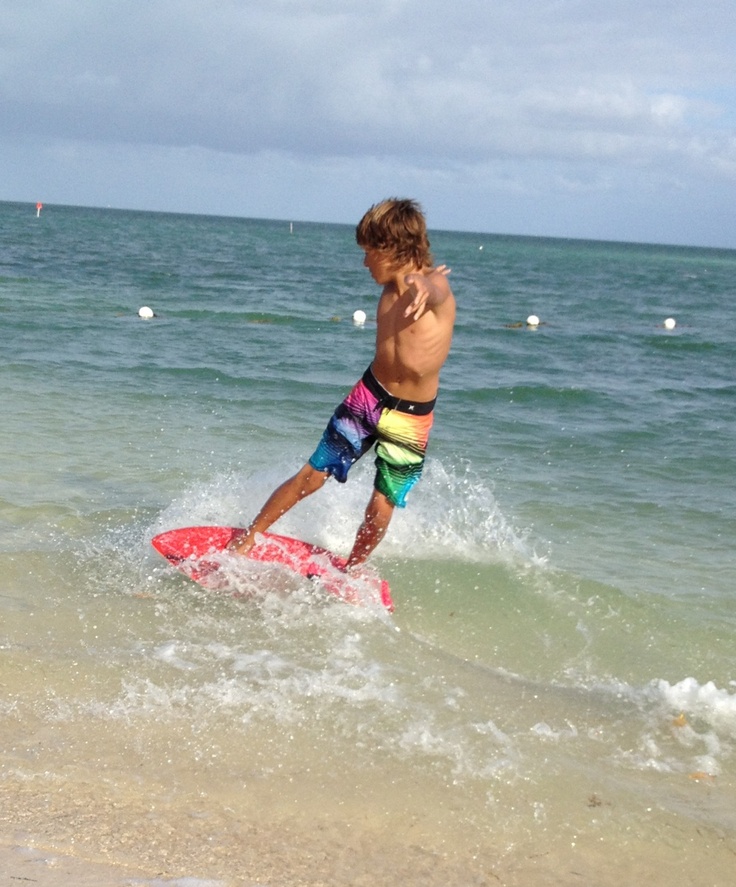
This is the sport for those who like the idea of surfing, but perhaps lack the patience for actual waves. Picture a nimble individual sprinting towards the receding tide with a thin board, looking like they're attempting a very stylish escape from a particularly low puddle. This brave soul then hurls the board onto the slick, wet sand and attempts to gracefully glide across it, often with the elegance of a newborn giraffe on an ice rink. The goal? To catch the very edge of a wave before it breaks, a feat often followed by an impressive, sandy face-plant.
The potential for beach mishaps will give you a powerful workout. That explosive sprint? Excellent for leg power and cardiovascular bursts. The constant balancing act on the moving board? Works wonders for core strength and stability. And the sheer agility required to jump on and off the board? Improves coordination and reaction time.
Best for: leg power, cardiovascular fitness, core strength, stability, coordination, and reaction time.
Other Sports Played in the Surf
Surf Kayaking — involves surfing in the ocean using a kayak.
Surfboat Rowing — a team of riders compete using surfboats on a course out and back through the surf.
Beach Sprint Rowing — short rowing race in the open water also involving a beach sprint.
Surf Lifesaving — competitions consist of performing various tasks performed by lifeguards on the beach.
Kitesurfing — a board and kite are used on the water utilizing different styles consisting of freeride, speed, down winders and racing.
Open Water Swimming — competitive swimming races conducted over various distances (10km at the Olympics) held in rivers, lakes and oceans.
Beach Water Polo — an open water version of water polo played on a smaller field with four players per team.
List of All Sports
